Jim Dine: The Glyptotek Drawings
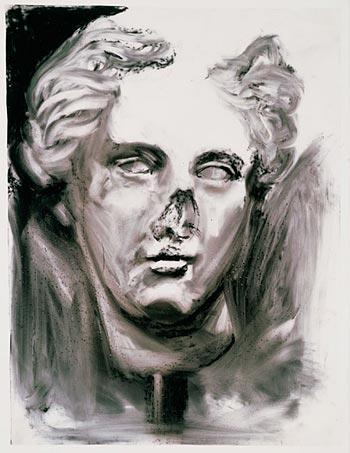
The flower delights my body's force.
It shines on the bitter-sweet limbs
Of our long companionship.
Moonlight covers the earth.
Jim Dine, "After Sappho," 1988
Read about materials and methods »
Painter, sculptor, draftsman, and poet, Jim Dine (American, born 1935) began his career in the early 1960s as a key figure in the development of performance art. He soon came to be associated with Pop Art because his drawings and paintings often depict a single object or everyday motif in isolation. Yet, in contrast to Pop, Dine charges his art with a deep personal investment, reworking and reimagining his sources until they become part of his own iconography. In the 1970s, draftsmanship became central to his practice, particularly in the form of life drawing, and in the 1980s he began a sustained series of drawings based on ancient sculpture.
In 1984, when Jim Dine first visited Munich's Glyptothek, a museum dedicated to antique sculpture, he was compelled to create a book of prints to house, in his own words, "my Glyptothek." In preparation for the prints he produced a series of forty drawings based on ancient sculpture, known as the Glyptotek Drawings. The entire suite forms a single work. "I think each individual drawing could stand alone," Dine said, "but as a single work all forty make a narrative about learning from the Ancient World." While the Munich museum sparked Dine's creative process, he made the drawings in his studio from in-situ sketches, photographs, postcards, and catalogues, incorporating ancient marbles from other museum collections as well.
Dine produced a number of other drawings related to the Glyptotek Drawings. Invited by the museum's director, Dine returned to the Munich Glyptothek in 1989; working alone at night in the galleries, he created a series of seventeen large-scale works. The following year, Dine traveled to the Ny Carlsberg Glyptotek in Copenhagen where over a course of seven days he worked in the galleries to create Seven Views of the Hermaphrodite, a testament to his skill as a draftsman. In his studio he continued to draw from antiquities, producing the three-part drawing Three Roman Heads, 1991, from the busts he had encountered in Copenhagen.
Jim Dine: The Glyptotek Drawings explores Dine's meditation on the antique world. In addition to the drawings, the exhibition features the book of prints based on them. Entitled Glyptotek, and published in limited edition in 1988, the book includes Dine's translation of a poem by Sappho (right), the seventh-century B.C. Greek poet known for her love poems.
All works are promised gifts of the artist to the Morgan.
This online exhibition is presented in conjunction with the exhibition Jim Dine: The Glyptotek Drawings on view May 20, 2011, through September 4, 2011.
Jim Dine (b. 1935)
Glyptotek Drawings
Charcoal and pastel on plastic sheet
17 x 13 inches
Promised gift of the artist to The Morgan Library & Museum. Photograph courtesy of The Pace Gallery. © 2009 Jim Dine / Artists Rights Society (ARS), New York
Glyptotek Drawings
Glyptotek Drawings [1]
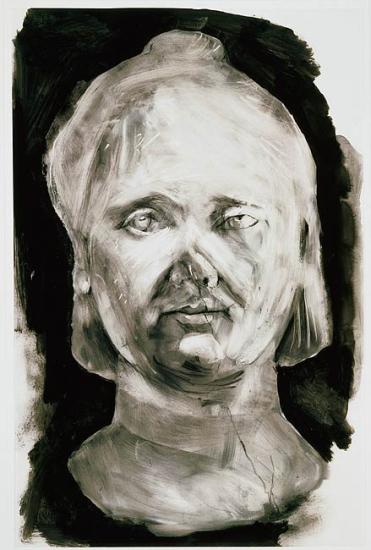
Glyptotek Drawings [1]
Photograph courtesy of The Pace Gallery.
© 2011 Jim Dine / Artists Rights Society (ARS), New York
Glyptotek Drawings [2]
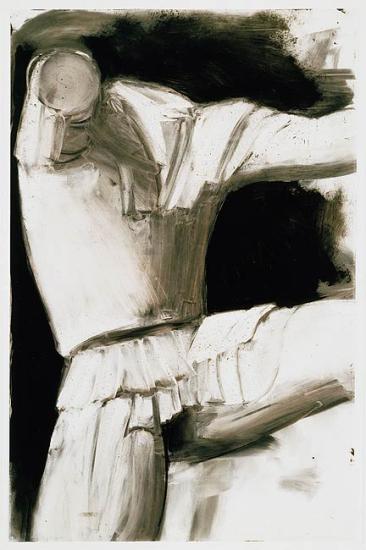
Glyptotek Drawings [2]
Here Dine is interested in the fragmentary quality of antique sculpture. Although the figure is centrally placed within the sheet, its jutting limbs make the composition explode into the viewer's space. By cropping the figure, Dine heightened the fragmentary nature of these objects.
Photograph courtesy of The Pace Gallery.
© 2011 Jim Dine / Artists Rights Society (ARS), New York
Glyptotek Drawings [3]
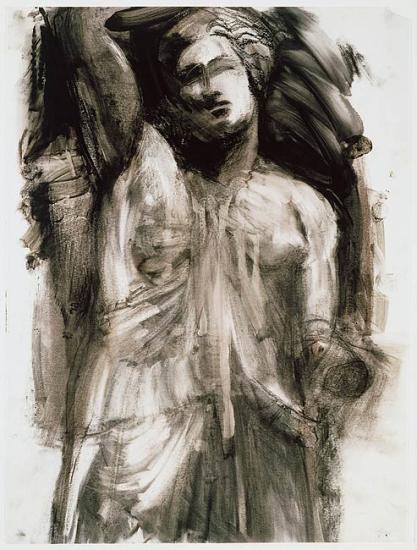
Glyptotek Drawings [3]
Dine's enthusiasm for materials and process is evident in the large, inky fingerprints (near the swaths of charcoal in the upper right corner) and in the abraded surface. He sanded the sheet with an emery board and picked at it with an etching-plate scraper and razor blade "to put more light into the drawing."
Photograph courtesy of The Pace Gallery.
© 2011 Jim Dine / Artists Rights Society (ARS), New York
Glyptotek Drawings [4]
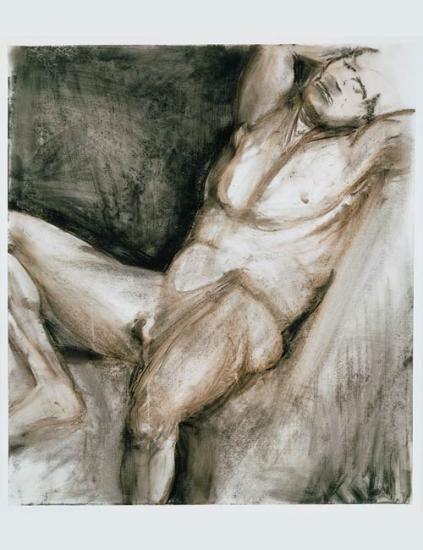
Glyptotek Drawings [1]
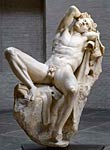 One of the most celebrated sculptures from antiquity, the Barberini Faun depicts a drunken, sleeping satyr, sprawled on a rock. In this sheet, Dine emphasized the satyr's dreamlike state and heightened the sculpture's sensual abandon with light washes that soften the rocky bed.
One of the most celebrated sculptures from antiquity, the Barberini Faun depicts a drunken, sleeping satyr, sprawled on a rock. In this sheet, Dine emphasized the satyr's dreamlike state and heightened the sculpture's sensual abandon with light washes that soften the rocky bed.
Barberini Faun, ca. 220 B.C.., Glyptothek, Munich
Staatliche Antikensammlungen und Glyprothek München
Photograph by : Renate Kühling
Photograph courtesy of The Pace Gallery.
© 2011 Jim Dine / Artists Rights Society (ARS), New York
Glyptotek Drawings [5]
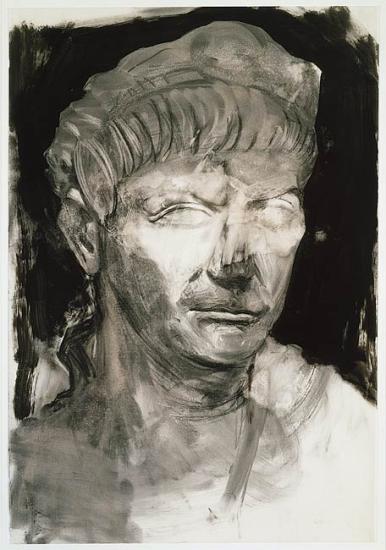
Glyptotek Drawings [5]
Photograph courtesy of The Pace Gallery.
© 2011 Jim Dine / Artists Rights Society (ARS), New York
Glyptotek Drawings [6]
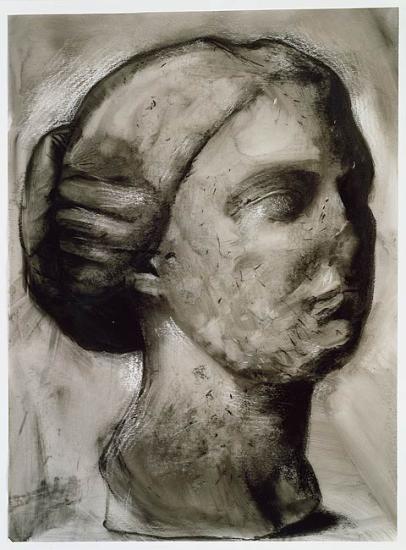
Glyptotek Drawings [6]
Of his process, Dine has said: "In a drawing, I dig into the paper with marks for the ultimate emotional impact." For all the Glyptotek Drawings, Dine chose to work solely with black media. The white patches highlighting the figure at her nape, forehead, and behind her hair are the result of the artist abrading the surface with a knife or scraper.
Photograph courtesy of The Pace Gallery.
© 2011 Jim Dine / Artists Rights Society (ARS), New York
Glyptotek Drawings [7]
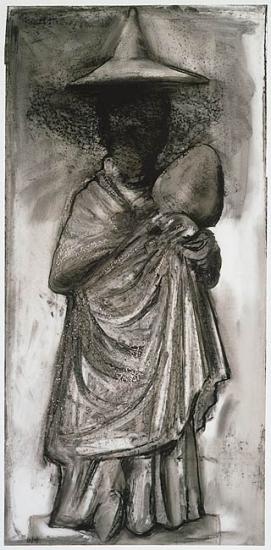
Glyptotek Drawings [7]
While the majority of the Glyptotek Drawings were inspired by antique marbles, this is one of two based on terra-cotta Tanagra figurines. Named after the site in central Greece where thousands of such figures were unearthed, these small sculptures depict draped women, often wearing hats and holding fans.
To produce the veil-like haze that obscures the figure's face, Dine used the frottage technique: he placed a rough surface underneath the plastic sheet and rubbed the drawing with a compressed charcoal crayon. "My work is based on the physical," he said. "The act of making this stuff is not contemplative. Nor is it what would be called conceptual."
Photograph courtesy of The Pace Gallery.
© 2011 Jim Dine / Artists Rights Society (ARS), New York
Glyptotek Drawings [8]
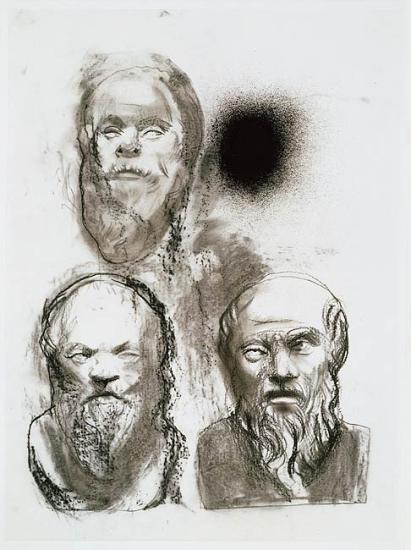
Glyptotek Drawings [8]
Dine drew these three studies of the head of Socrates, the fourth- century B.C.. philosopher, from the same frontal viewpoint, but he worked them to various degrees. Dine directly applied spray enamel onto the sheet, creating a burst of rich black in the top right corner.
Photograph courtesy of The Pace Gallery.
© 2011 Jim Dine / Artists Rights Society (ARS), New York
Glyptotek Drawings [9]
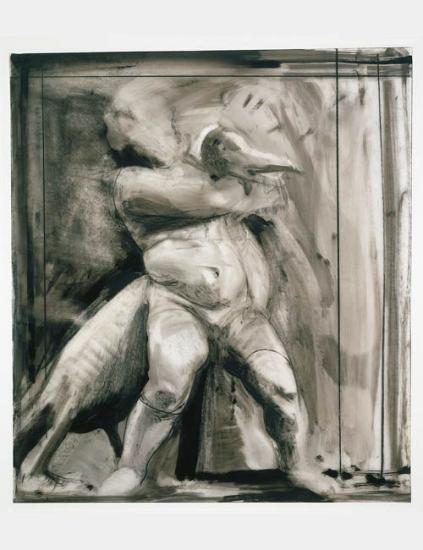
Glyptotek Drawings [9]
The sculpture depicts a young child playfully struggling with a goose, a popular subject in antiquity. Dine intensified the goose's struggle with three strokes that seem to emanate from the bird's head, recall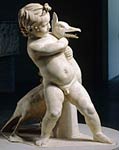 ing the expressive shorthand for exertion often found in comic books and cartoons.
ing the expressive shorthand for exertion often found in comic books and cartoons.
Dine's consideration of the printing process is evident in this sheet. The nearly square drawing was larger than the printing plate. The ruled lines framing the figure mark the limits of the printed image. In the Glyptotek book, the back leg and tail of the goose is cut off.
Boy with a Goose, ca. 250–200 B.C.., Glyptothek, Munich
Staatliche Antikensammlungen und Glyprothek München
Photograph by : Renate Kühling
Photograph courtesy of The Pace Gallery.
© 2011 Jim Dine / Artists Rights Society (ARS), New York
Glyptotek Drawings [10]
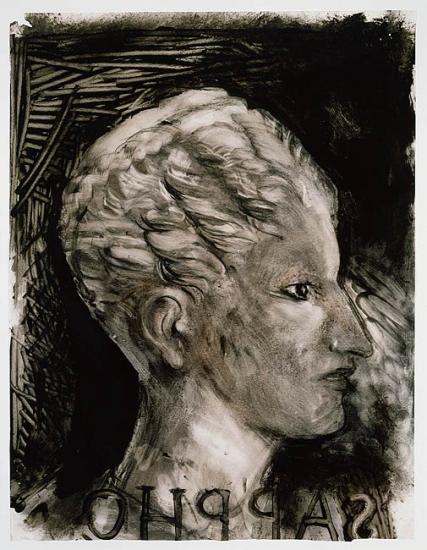
Glyptotek Drawings [10]
Dine's conception of the Glyptotek project began with a literary reference: "I knew from the start I wanted to include Sappho." This drawing of the seventh-century-B.C.. poet is one of the earliest in the series. The sheet is more heavily worked and detailed, especially around the eyes and in the profile. As the series progressed, Dine abandoned this approach and his marks became more gestural.
This is the only sheet in the series that includes text, which appears backward owing to the printing process. The composition is reversed on both the drawing and the printing plate; the inked printing plate transfers the image to the final sheet and inverts it.
Photograph courtesy of The Pace Gallery.
© 2011 Jim Dine / Artists Rights Society (ARS), New York
Glyptotek Drawings [11]
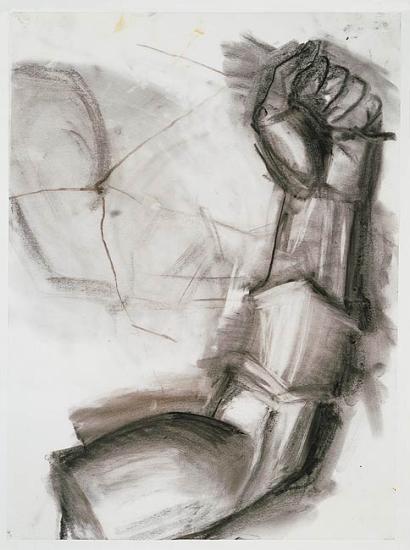
Glyptotek Drawings [11]
In creating the Glyptotek drawings, Dine was drawn to the sculptures' imperfections: "I like to honor any accident or destruction of the marks that will enhance a new beginning." The chipped noses, broken limbs, and irregular surfaces reveal the passage of time, yet their fragmentary nature also speaks to a very modern aesthetic. This is evident in the flat, unmoored quality of the soldier's arm. In reality, the unspecified background space is the back of the soldier's shield. Dine has further altered the subject's orientation, rotating the fallen warrior's arm from a horizontal to a vertical position.
Photograph courtesy of The Pace Gallery.
© 2011 Jim Dine / Artists Rights Society (ARS), New York
Glyptotek Drawings [12]
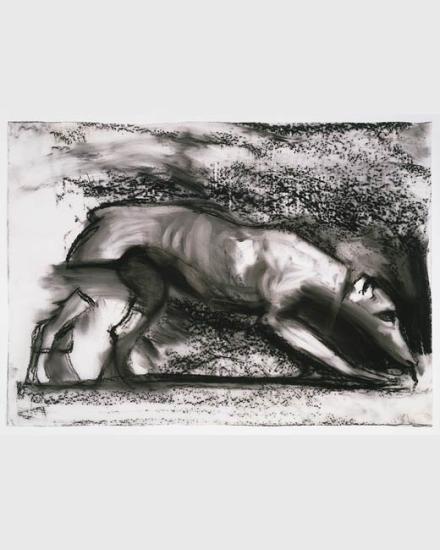
Glyptotek Drawings [12]
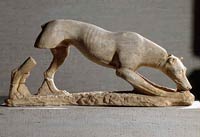 In Ancient Greece, graves were marked with stelae ornamented with relief depictions of the deceased and their attributes. This hunting hound originally marked a grave site. The dog is depicted in mourning, with its head down and nose to the ground.
In Ancient Greece, graves were marked with stelae ornamented with relief depictions of the deceased and their attributes. This hunting hound originally marked a grave site. The dog is depicted in mourning, with its head down and nose to the ground.
Hunting Hound, ca. 350 B.C.., Glyptothek, Munich
Staatliche Antikensammlungen und Glyprothek München
Photograph by : Renate Kühling
Photograph courtesy of The Pace Gallery.
© 2011 Jim Dine / Artists Rights Society (ARS), New York
Glyptotek Drawings [13]

Glyptotek Drawings [13]
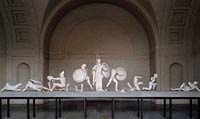 The wounded soldier depicted here comes from the west pediment of the Temple of Aphaia in Aegina (ca. 485–480 B.C..). The triangular frame of the pediment (the space formed by the pitch of the roof) determined the composition of the sculptural program, which represents a battle between Greeks and Trojans. The fallen warrior, lying on his side, is situated at the far right corner of the architectural element.
The wounded soldier depicted here comes from the west pediment of the Temple of Aphaia in Aegina (ca. 485–480 B.C..). The triangular frame of the pediment (the space formed by the pitch of the roof) determined the composition of the sculptural program, which represents a battle between Greeks and Trojans. The fallen warrior, lying on his side, is situated at the far right corner of the architectural element.
West Pediment, Temple of Aphaia, Aegina, Glyptothek, Munich
Staatliche Antikensammlungen und Glyprothek München
Photograph by : Renate Kühling
Photograph courtesy of The Pace Gallery.
© 2011 Jim Dine / Artists Rights Society (ARS), New York
Glyptotek Drawings [14]
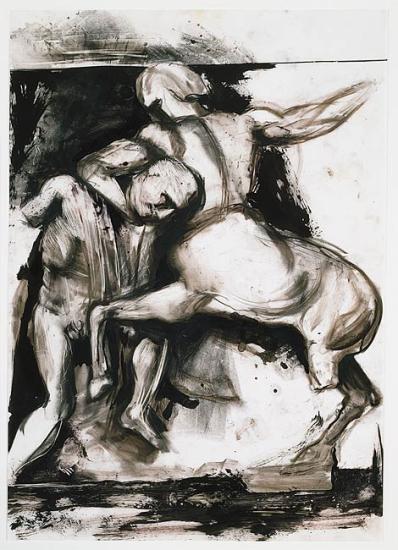
Glyptotek Drawings [14]
Photograph courtesy of The Pace Gallery.
© 2011 Jim Dine / Artists Rights Society (ARS), New York
Glyptotek Drawings [15]

Glyptotek Drawings [15]
Photograph courtesy of The Pace Gallery.
© 2011 Jim Dine / Artists Rights Society (ARS), New York
Glyptotek Drawings [16]
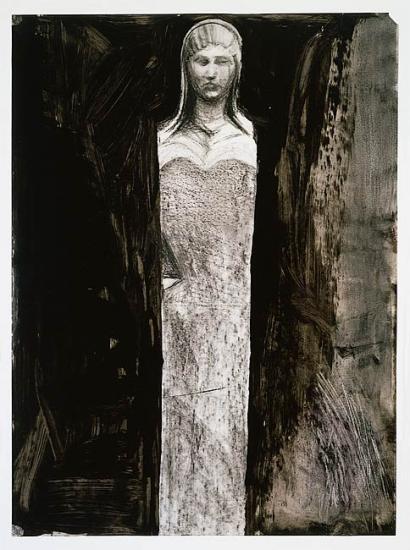
Glyptotek Drawings [16]
Photograph courtesy of The Pace Gallery.
© 2011 Jim Dine / Artists Rights Society (ARS), New York
Glyptotek Drawings [17]
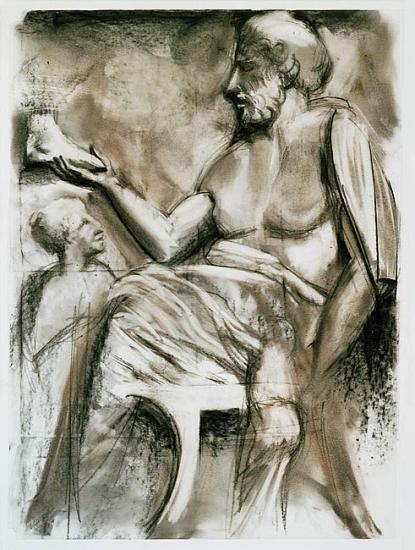
Glyptotek Drawings [17]
In creating his own Glyptotek, Dine recalled, "I built it from photos and postcards and books on the ancient world." This drawing was inspired by the marble gravestone of Xanthippos, now in the British Museum, London.
In ancient Greece, graves were marked with stelae ornamented with relief depictions of the deceased. This relief represented a shoemaker framed within an architectural setting. Dine did away with any sense of an architectural space, thereby enhancing the figure's immediacy.
Photograph courtesy of The Pace Gallery.
© 2011 Jim Dine / Artists Rights Society (ARS), New York
Glyptotek Drawings [18]
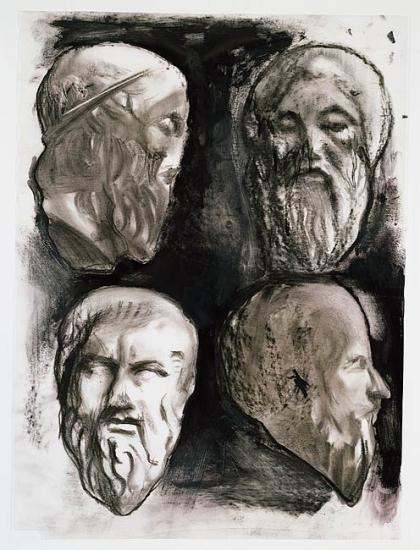
Glyptotek Drawings [18]
This sheet presents a frontal and profile view of Homer at the top and one of Plato at the bottom. Homer, the eighth-century-B.C.. blind poet credited with the Iliad and the Odyssey, is identifiable by his lidded eyes. Like Homer, the Athenian philosopher Plato (429–347 B.C..) is depicted with his mouth slightly agape. The disembodied heads appear removed from the everyday world, lost in contemplative tranquility.
Photograph courtesy of The Pace Gallery.
© 2011 Jim Dine / Artists Rights Society (ARS), New York
Glyptotek Drawings [19]
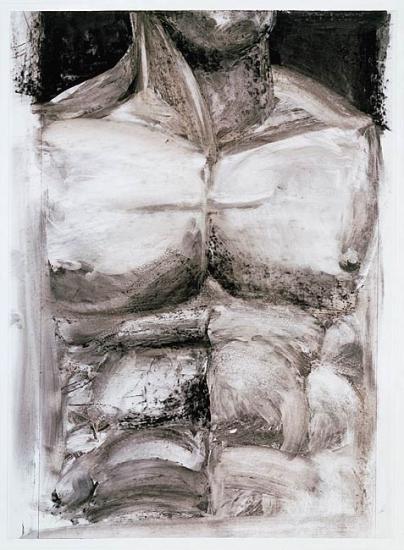
Glyptotek Drawings [19]
Photograph courtesy of The Pace Gallery.
© 2011 Jim Dine / Artists Rights Society (ARS), New York
Glyptotek Drawings [20]
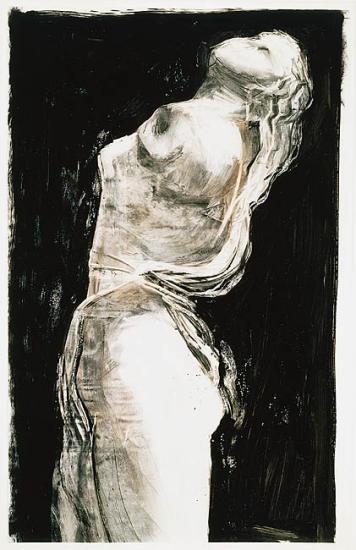
Glyptotek Drawings [20]
In 1979 Dine said, "I'm looking more at ancient art now, because I'm trying to understand sculpture." In the present work, Dine stressed the dialogue between sculpture and drawing by scratching into the drawing's surface. This subtractive process is particularly evident in the drapery folds that define the figure.
This drawing was inspired by a sculpture commonly referred to as the Dresden Maenad, in the collection of the Skulpturensammlung Staatliche Kunstsammlungen, Dresden, Germany. A term for a female follower of Dionysus, the Greek god of wine, Maenads are often depicted dancing or in a state of divine frenzy. This drawing is remarkable for its dramatic perspective and sense of movement, established by the low point of view and the figure twisting towards us.
Photograph courtesy of The Pace Gallery.
© 2011 Jim Dine / Artists Rights Society (ARS), New York
Glyptotek Drawings [21]
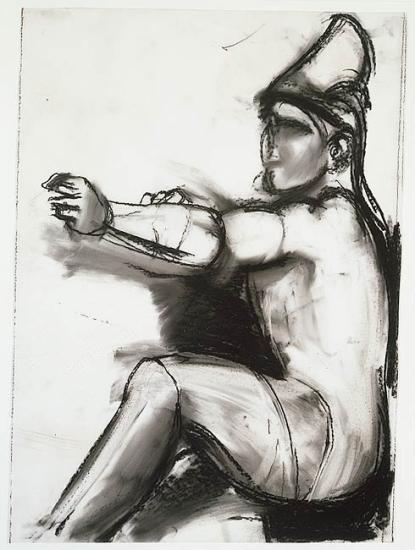
Glyptotek Drawings [21]
In choosing his sculptural sources, Dine was drawn to single-figure compositions and rarely chose multi-figure groups. He extracted the subject of this drawing, an archer sometimes identified as Paris, Prince of Troy, from the west pediment of the Temple of Aphaia in Aegina (ca. 485–480 BC). Reconstructed at the Glyptothek, Munich, the pediment’s sculptural program depicts the Trojan War and features several figures interacting in battle. Dine chose to omit the overlapping figures in favor of a more concentrated study of the archer.
Photograph courtesy of The Pace Gallery.
© 2011 Jim Dine / Artists Rights Society (ARS), New York
Glyptotek Drawings [22]
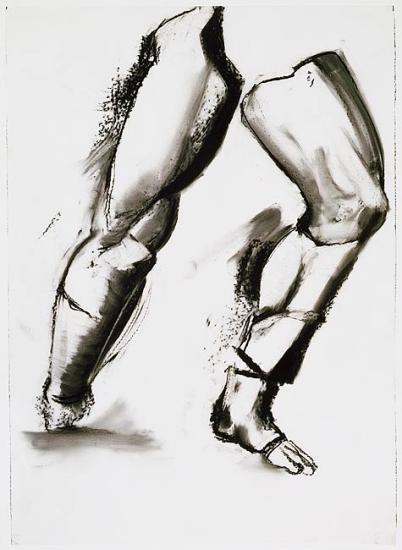
Glyptotek Drawings [22]
Photograph courtesy of The Pace Gallery.
© 2011 Jim Dine / Artists Rights Society (ARS), New York
Glyptotek Drawings [23]
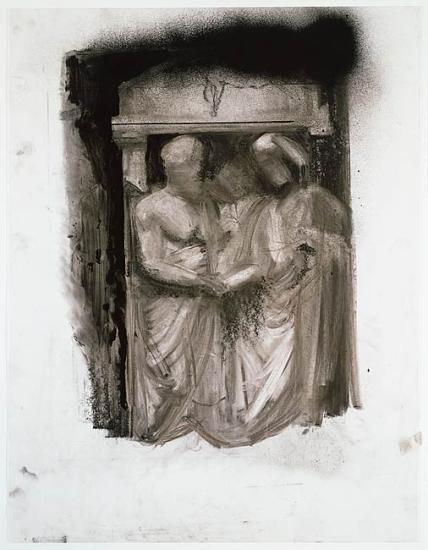
Glyptotek Drawings [23]
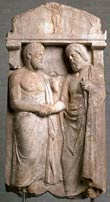 This sheet combines a rich variety of media—india ink, charcoal, and spray paint. In keeping with the fragmented base of the Grave Stele of Artemon, Dine left the lower half of the sheet empty. In contrast, the top is heavily worked and marked by a direct application of spray paint.
This sheet combines a rich variety of media—india ink, charcoal, and spray paint. In keeping with the fragmented base of the Grave Stele of Artemon, Dine left the lower half of the sheet empty. In contrast, the top is heavily worked and marked by a direct application of spray paint.
Grave Stele of Artemon, ca. 350 B.C.., Glyptothek, Munich
Staatliche Antikensammlungen und Glyprothek München
Photograph by : Renate Kühling
Photograph courtesy of The Pace Gallery.
© 2011 Jim Dine / Artists Rights Society (ARS), New York
Glyptotek Drawings [24]
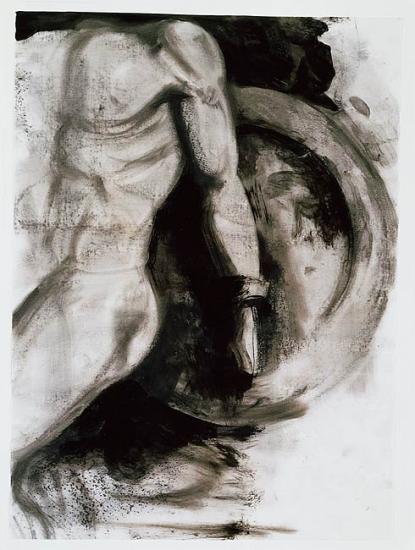
Glyptotek Drawings [24]
Photograph courtesy of The Pace Gallery.
© 2011 Jim Dine / Artists Rights Society (ARS), New York
Glyptotek Drawings [25]
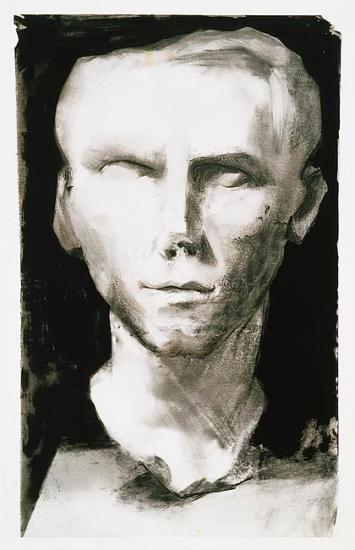
Glyptotek Drawings [25]
Photograph courtesy of The Pace Gallery.
© 2011 Jim Dine / Artists Rights Society (ARS), New York
Glyptotek Drawings [26]
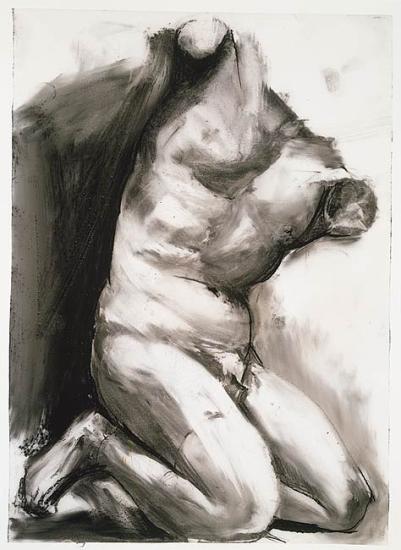
Glyptotek Drawings [26]
 This is one of two drawings inspired by a sculpture of a kneeling youth protecting himself from an impending attack. It is the only figure Dine repeated throughout the forty Glyptotek Drawings. He revisited the figure in the drawing Twisted Torso of A Youth (Ilioneus, ca. 300 BC), 1989, also on view in the exhibition.
This is one of two drawings inspired by a sculpture of a kneeling youth protecting himself from an impending attack. It is the only figure Dine repeated throughout the forty Glyptotek Drawings. He revisited the figure in the drawing Twisted Torso of A Youth (Ilioneus, ca. 300 BC), 1989, also on view in the exhibition.
Torso of a Kneeling Athlete, ca. 300 B.C.., Glyptothek, Munich
Staatliche Antikensammlungen und Glyprothek München
Photograph by : Renate Kühling
Photograph courtesy of The Pace Gallery.
© 2011 Jim Dine / Artists Rights Society (ARS), New York
Glyptotek Drawings [27]
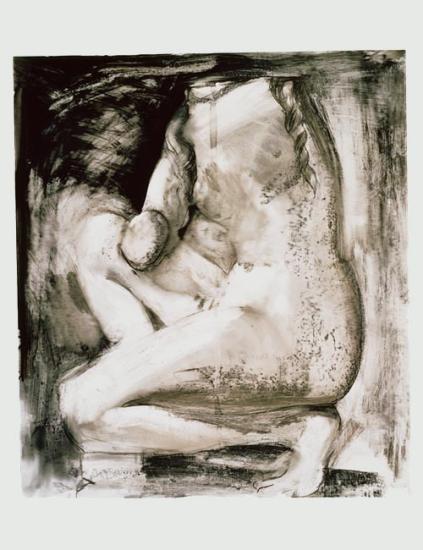
Glyptotek Drawings [27]
Dine chose to work on translucent paper and plastic sheets to give the drawings "some sense of light." These unconventional supports allowed for little absorption and afforded the artist a great degree of creative play. He manipulated the unfixed materials with a variety of tools—from erasers and knives to his own fingers. Here, Dine's incorporation of random effects can be seen in the line of fixative that runs directly down the center of the sheet.
Photograph courtesy of The Pace Gallery.
© 2011 Jim Dine / Artists Rights Society (ARS), New York
Glyptotek Drawings [28]

Glyptotek Drawings [28]
While the majority of the Glyptotek Drawings were inspired by antique marbles, this is one of two drawings based on terra cotta Tanagra figurines. Named after the site in central Greece where thousands of such figures were unearthed, these small sculptures depict draped women, often wearing a hat and holding a fan.
Photograph courtesy of The Pace Gallery.
© 2011 Jim Dine / Artists Rights Society (ARS), New York
Glyptotek Drawings [29]
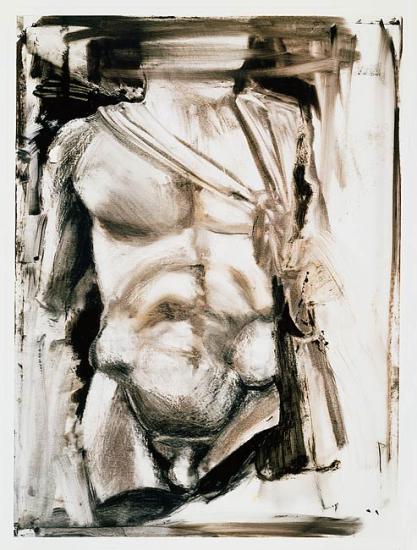
Glyptotek Drawings [29]
Photograph courtesy of The Pace Gallery.
© 2011 Jim Dine / Artists Rights Society (ARS), New York
Glyptotek Drawings [30]
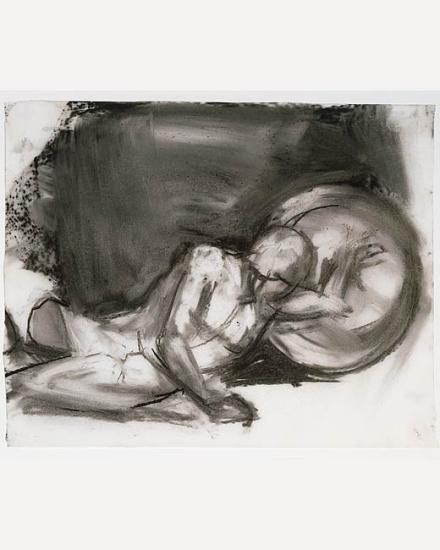
Glyptotek Drawings [30]
Photograph courtesy of The Pace Gallery.
© 2011 Jim Dine / Artists Rights Society (ARS), New York
Glyptotek Drawings [31]
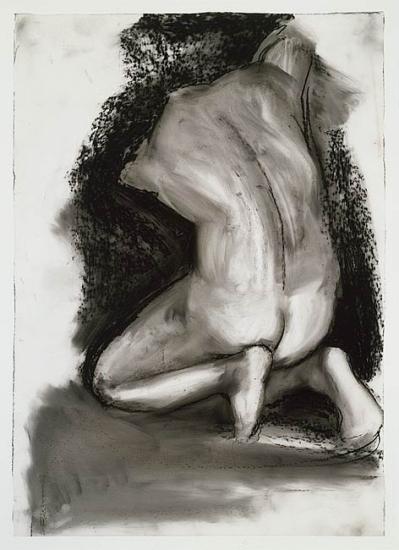
Glyptotek Drawings [31]
Here, Dine used an eraser not only to remove marks but also to manipulate the materials. For instance, the broad strokes of white along the figure's back result from wiping wet charcoal across the surface. The small specks are debris from Dine's eraser. Of these he commented: "I just left my tracks, as I often do."
Photograph courtesy of The Pace Gallery.
© 2011 Jim Dine / Artists Rights Society (ARS), New York
Glyptotek Drawings [32]
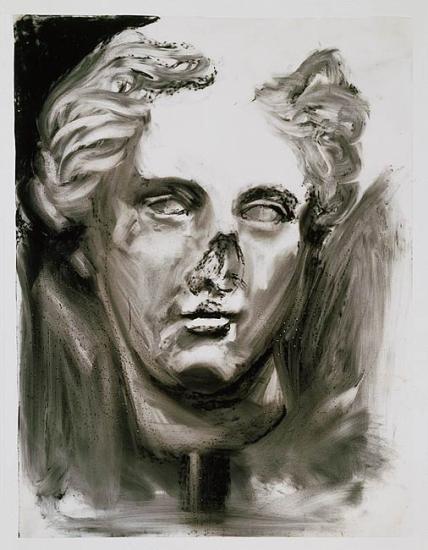
Glyptotek Drawings [32]
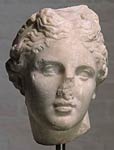 Dine's physical engagement with his materials is evident in the sensual treatment of Aphrodite's hair. He used his fingers to shape the charcoal, create highlights, and heighten the sense of movement.
Dine's physical engagement with his materials is evident in the sensual treatment of Aphrodite's hair. He used his fingers to shape the charcoal, create highlights, and heighten the sense of movement.
I choose things that I think can come alive. I don't want to draw these things as dead objects, as stone. I want to observe them carefully, and then I want to put life into them and make them vigorous and physical.
Head of Aphrodite, ca. 300 B.C.., Glyptothek, Munich
Staatliche Antikensammlungen und Glyprothek München
Photograph by : Renate Kühling
Photograph courtesy of The Pace Gallery.
© 2011 Jim Dine / Artists Rights Society (ARS), New York
Glyptotek Drawings [33]
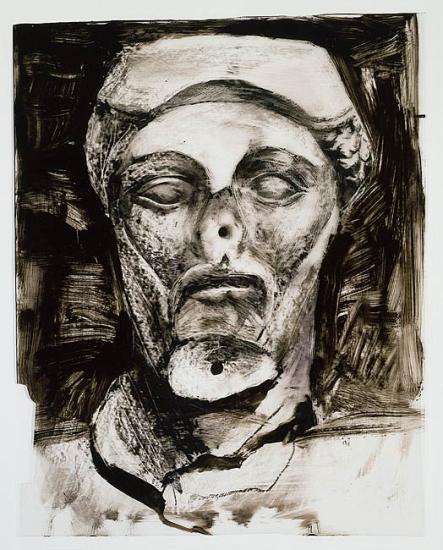
Glyptotek Drawings [33]
In 2004, Dine wrote: "A drawing is something you carve out of the paper rather than laying it on top. It is about the pressure, the physical pressure of exerting your hand with some sort of stylus... onto paper or canvas." This sheet, marked by rough passages and incisions, exemplifies Dine's conception of drawing as a physical process.
Photograph courtesy of The Pace Gallery.
© 2011 Jim Dine / Artists Rights Society (ARS), New York
Glyptotek Drawings [34]
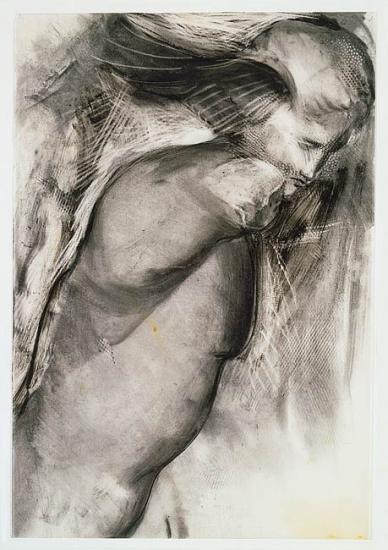
Glyptotek Drawings [34]
This drawing is characterized by a bold lattice-like pattern that Dine created with a wire mesh screen; first he used the screen to remove charcoal from the surface then transferred the charcoal by laying the screen down on another section of the sheet.
In making his "own Glyptothek" Dine referenced materials from other museum collections. This drawing was inspired by a statue of Hypnos, the personification of sleep, from the Museo del Prado, Madrid.
Photograph courtesy of The Pace Gallery.
© 2011 Jim Dine / Artists Rights Society (ARS), New York
Glyptotek Drawings [35]
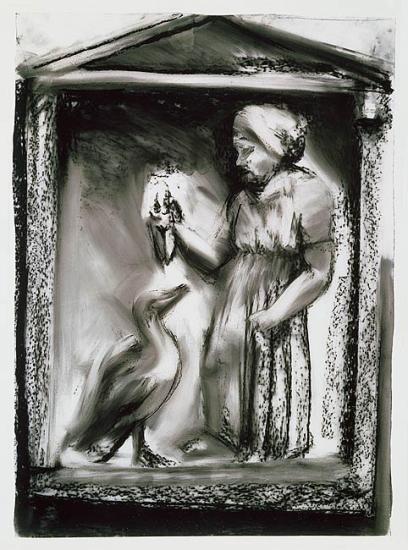
Glyptotek Drawings [35]
 This grave stele depicts a young girl tenderly playing with a doll and goose. With his strong interplay of light and shadow as well as the contrast between sweeping strokes and rough surface textures, Dine imbued this image with romantic tone. It is a hauntingly modern vision of the ancient world.
This grave stele depicts a young girl tenderly playing with a doll and goose. With his strong interplay of light and shadow as well as the contrast between sweeping strokes and rough surface textures, Dine imbued this image with romantic tone. It is a hauntingly modern vision of the ancient world.
Grave Stele of a Girl with a Doll and a Goose, ca. 370–360 B.C.., Glyptothek, Munich
Staatliche Antikensammlungen und Glyprothek München
Photograph by : Renate Kühling
Photograph courtesy of The Pace Gallery.
© 2011 Jim Dine / Artists Rights Society (ARS), New York
Glyptotek Drawings [36]
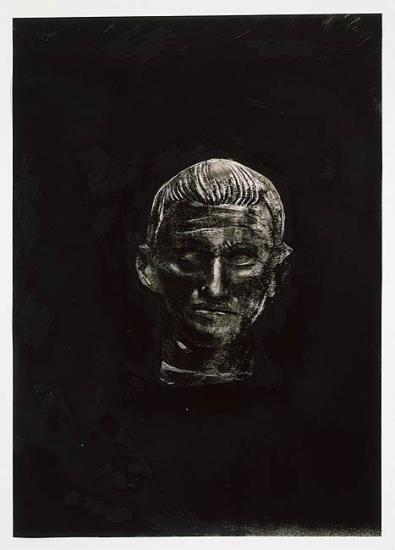
Glyptotek Drawings [36]
This drawing represents the lengths to which Dine searched for an opaque background, resulting in the print version in a rich, inky intaglio print devoid of white space. To create such a dense image, Dine first drew the portrait in charcoal and covered the entire background with spray paint. He then used a variety of media, including chalk, charcoal, and liquid varnish to fill in any translucent holes.
Photograph courtesy of The Pace Gallery.
© 2011 Jim Dine / Artists Rights Society (ARS), New York
Glyptotek Drawings [37]
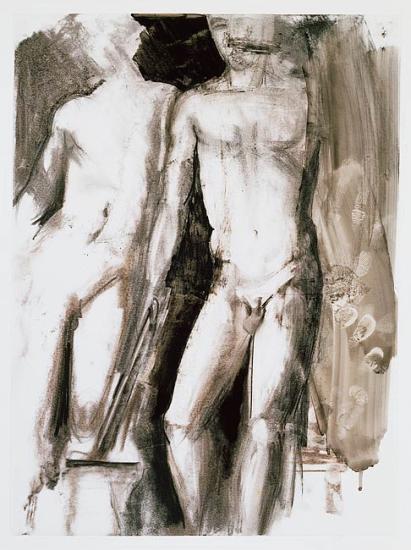
Glyptotek Drawings [37]
Photograph courtesy of The Pace Gallery.
© 2011 Jim Dine / Artists Rights Society (ARS), New York
Glyptotek Drawings [38]
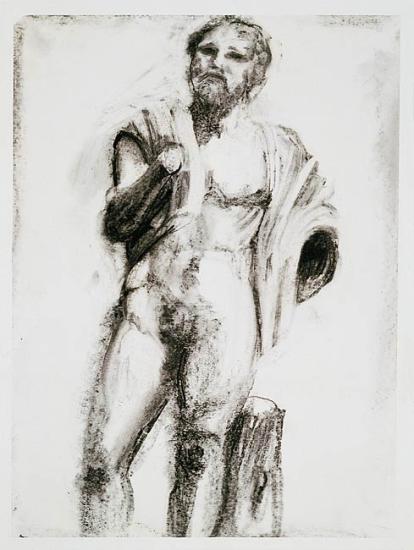
Glyptotek Drawings [38]
Photograph courtesy of The Pace Gallery.
© 2011 Jim Dine / Artists Rights Society (ARS), New York
Glyptotek Drawings [39]
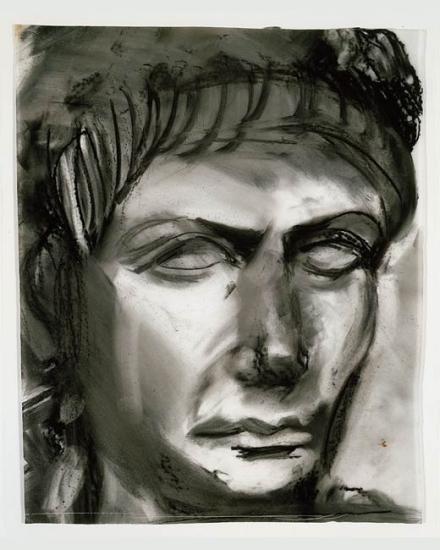
Glyptotek Drawings [39]
 In the big hall of Roman portrait heads there must be over one hundred heads. You feel like you're in a crowd of people, but there is nothing heroic about it. It's very much on a human scale, right at the viewer's eye level.
In the big hall of Roman portrait heads there must be over one hundred heads. You feel like you're in a crowd of people, but there is nothing heroic about it. It's very much on a human scale, right at the viewer's eye level.
Hall of the Romans, Glyptothek, Munich
Staatliche Antikensammlungen und Glyprothek München
Photograph by : Renate Kühling
Photograph courtesy of The Pace Gallery.
© 2011 Jim Dine / Artists Rights Society (ARS), New York
Glyptotek Drawings [40]
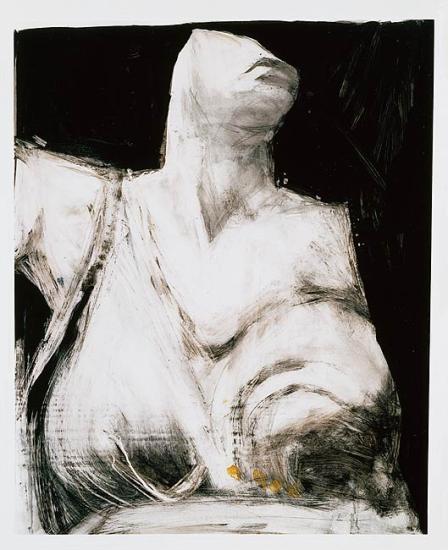
Glyptotek Drawings [40]
Photograph courtesy of The Pace Gallery.
© 2011 Jim Dine / Artists Rights Society (ARS), New York
Seven Views of the Hermaphrodite [1]
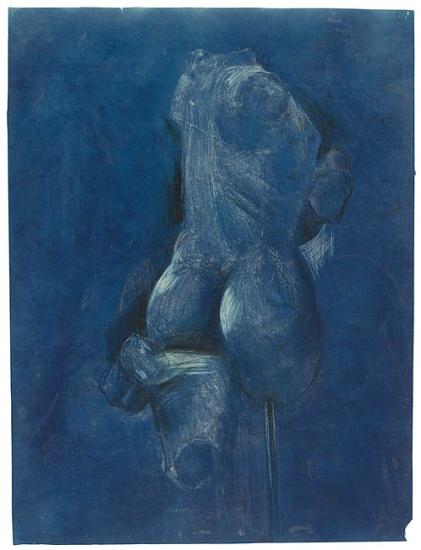
Seven Views of the Hermaphrodite [1]
In 1990 Dine traveled to the Ny Carlsberg Glyptotek in Copenhagen, where he spent seven days in the galleries to create this seven-part work, based on a statue of a hermaphrodite.
To highlight the subject's dual sexuality, antique sculptures of hermaphrodites typically display the figure in a complex, twisting pose. In each drawing, Dine depicted the figure from a different viewpoint. The sequence invokes the movement of the turning figure and its ability to define the space around it.
© 2011 Jim Dine / Artists Rights Society (ARS), New York
Seven Views of the Hermaphrodite [2]
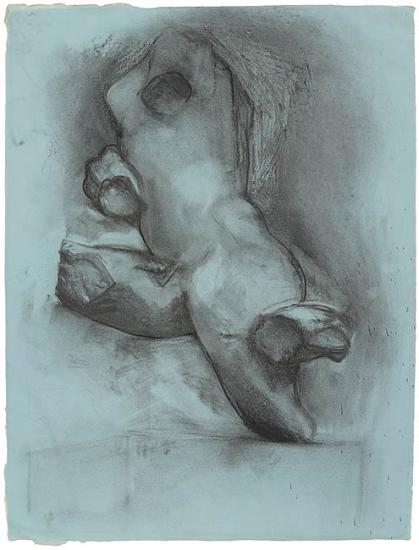
Seven Views of the Hermaphrodite [2]
In 1990 Dine traveled to the Ny Carlsberg Glyptotek in Copenhagen, where he spent seven days in the galleries to create this seven-part work, based on a statue of a hermaphrodite.
To highlight the subject's dual sexuality, antique sculptures of hermaphrodites typically display the figure in a complex, twisting pose. In each drawing, Dine depicted the figure from a different viewpoint. The sequence invokes the movement of the turning figure and its ability to define the space around it.
© 2011 Jim Dine / Artists Rights Society (ARS), New York
Seven Views of the Hermaphrodite [3]
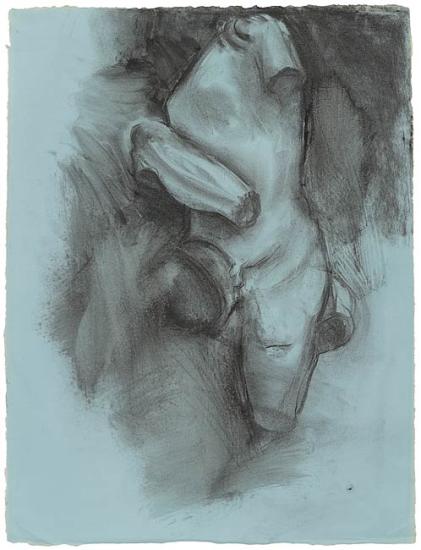
Seven Views of the Hermaphrodite [3]
In 1990 Dine traveled to the Ny Carlsberg Glyptotek in Copenhagen, where he spent seven days in the galleries to create this seven-part work, based on a statue of a hermaphrodite.
To highlight the subject's dual sexuality, antique sculptures of hermaphrodites typically display the figure in a complex, twisting pose. In each drawing, Dine depicted the figure from a different viewpoint. The sequence invokes the movement of the turning figure and its ability to define the space around it.
© 2011 Jim Dine / Artists Rights Society (ARS), New York
Seven Views of the Hermaphrodite [4]

Seven Views of the Hermaphrodite [4]
In 1990 Dine traveled to the Ny Carlsberg Glyptotek in Copenhagen, where he spent seven days in the galleries to create this seven-part work, based on a statue of a hermaphrodite.
To highlight the subject's dual sexuality, antique sculptures of hermaphrodites typically display the figure in a complex, twisting pose. In each drawing, Dine depicted the figure from a different viewpoint. The sequence invokes the movement of the turning figure and its ability to define the space around it.
© 2011 Jim Dine / Artists Rights Society (ARS), New York
Seven Views of the Hermaphrodite [5]
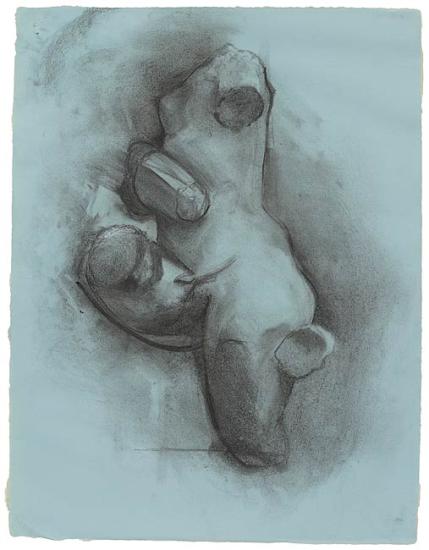
Seven Views of the Hermaphrodite [5]
In 1990 Dine traveled to the Ny Carlsberg Glyptotek in Copenhagen, where he spent seven days in the galleries to create this seven-part work, based on a statue of a hermaphrodite.
To highlight the subject's dual sexuality, antique sculptures of hermaphrodites typically display the figure in a complex, twisting pose. In each drawing, Dine depicted the figure from a different viewpoint. The sequence invokes the movement of the turning figure and its ability to define the space around it.
© 2011 Jim Dine / Artists Rights Society (ARS), New York
Seven Views of the Hermaphrodite [6]

Seven Views of the Hermaphrodite [6]
In 1990 Dine traveled to the Ny Carlsberg Glyptotek in Copenhagen, where he spent seven days in the galleries to create this seven-part work, based on a statue of a hermaphrodite.
To highlight the subject's dual sexuality, antique sculptures of hermaphrodites typically display the figure in a complex, twisting pose. In each drawing, Dine depicted the figure from a different viewpoint. The sequence invokes the movement of the turning figure and its ability to define the space around it.
© 2011 Jim Dine / Artists Rights Society (ARS), New York
Seven Views of the Hermaphrodite [7]
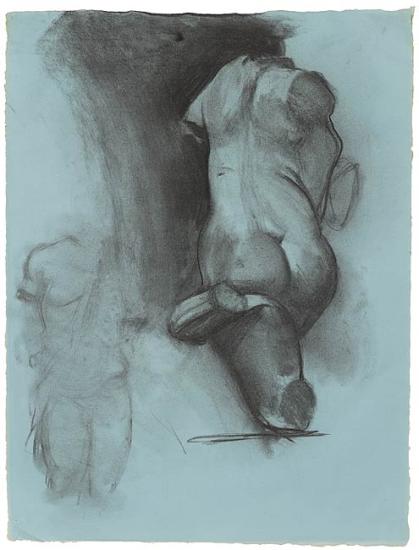
Seven Views of the Hermaphrodite [7]
In 1990 Dine traveled to the Ny Carlsberg Glyptotek in Copenhagen, where he spent seven days in the galleries to create this seven-part work, based on a statue of a hermaphrodite.
To highlight the subject's dual sexuality, antique sculptures of hermaphrodites typically display the figure in a complex, twisting pose. In each drawing, Dine depicted the figure from a different viewpoint. The sequence invokes the movement of the turning figure and its ability to define the space around it.
© 2011 Jim Dine / Artists Rights Society (ARS), New York
Twisted Torso of a Youth
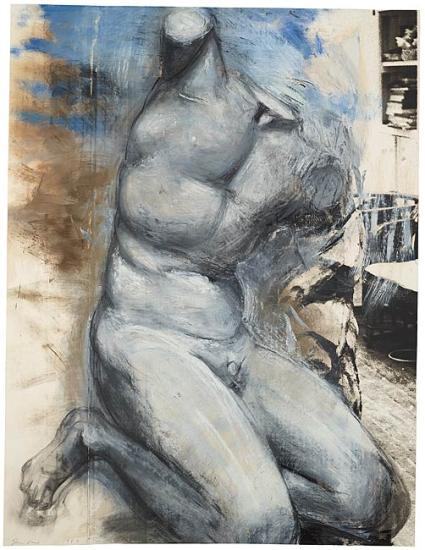
Twisted Torso of a Youth
1989
Dine made this drawing of an antique sculpture from the Munich Glyptothek in his London studio. He drew the figure of the twisted youth onto a screen print he had made from a photograph that his wife had taken of the studio. The sheet combines multiple layers of Dine's creative engagement with the antique: his studio photograph beneath the drawing shows the artist at work on a life-sized sculpture of Venus.
© 2011 Jim Dine / Artists Rights Society (ARS), New York
Three Roman Heads [1]

Three Roman Heads [1]
1991
These three drawings, made from photographs of sculptures from the Ny Carlsberg Glyptotek in Copenhagen, demonstrate the artist's physical approach to draftsmanship. Using large sheets of thick handmade paper, he applied his media in a highly gestural manner. Vigorously reworking each image, Dine exploited the expressive effects of accumulation, abrasion, and erasure.
© 2011 Jim Dine / Artists Rights Society (ARS), New York
Three Roman Heads [2]
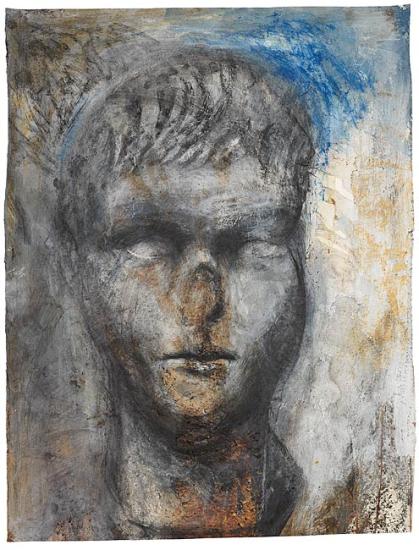
Three Roman Heads [2]
1991
These three drawings, made from photographs of sculptures from the Ny Carlsberg Glyptotek in Copenhagen, demonstrate the artist's physical approach to draftsmanship. Using large sheets of thick handmade paper, he applied his media in a highly gestural manner. Vigorously reworking each image, Dine exploited the expressive effects of accumulation, abrasion, and erasure.
© 2011 Jim Dine / Artists Rights Society (ARS), New York
Three Roman Heads [3]
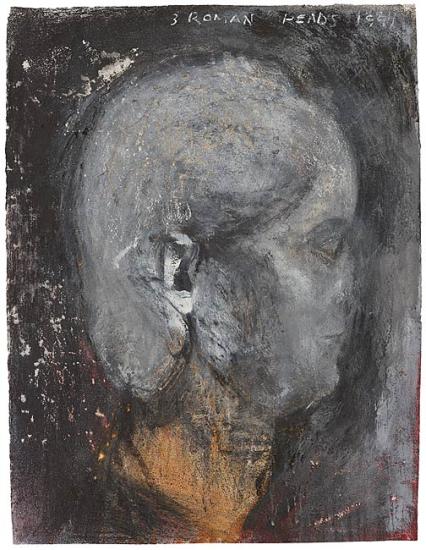
Three Roman Heads [3]
1991
These three drawings, made from photographs of sculptures from the Ny Carlsberg Glyptotek in Copenhagen, demonstrate the artist's physical approach to draftsmanship. Using large sheets of thick handmade paper, he applied his media in a highly gestural manner. Vigorously reworking each image, Dine exploited the expressive effects of accumulation, abrasion, and erasure.
© 2011 Jim Dine / Artists Rights Society (ARS), New York
Jim Dine: Drawing with Light
This post was created by Lindsey Tyne, Sherman Fairchild Post Graduate Fellow in Paper Conservation.
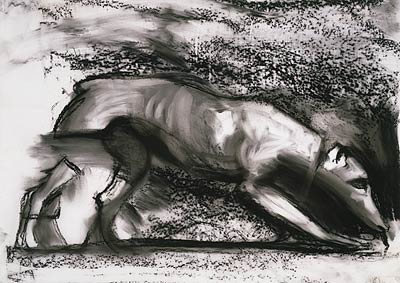
Jim Dine (b. 1935) Glyptotek Drawings Charcoal on Mylar. 17 x 13 inches (43.2 x 33 cm) Promised gift of the artist to The Morgan Library & Museum. Photograph courtesy of The Pace Gallery. © 2009 Jim Dine / Artists Rights Society (ARS), New York
Jim Dine was inspired by a 1984 trip to The Glyptothek in Munich, to create a series of figurative drawings based on Greek and Roman antiquities; they would ultimately function as positive transparencies in the production of the heliogravure prints (helio — "light"; gravure — "engraving") for his limited edition book Glyptotek, 1988. Due to the ultimate function of these drawings, Dine used materials that would either block or transmit light and, thus, was restricted to the use of opaque black media on translucent supports. Over the course of two winters from 1987-1988 in a studio in Venice, Italy, Dine created forty drawings in this manner, working from photographic reproductions of antique sculptures. These drawings make up his body of work known as the Glyptotek Drawings.
Translucent vs. Opaque
"The drawings are about light, as is the technique used to transfer them to the plates."
—Dine, December 22, 2010
Light was an essential factor in Dine's choice of materials, guiding him as he purchased supplies from local art supply stores. The ability of light to pass through the drawings was heavily dependent on the type of support, thus Dine's main criterion was its degree of translucency. Dine used three different categories of supports to fulfill this requirement: clear plastic sheets, frosted plastic sheets, and translucent paper. Dine claims to have had no preference for one type of support over the other; however, more than half of the drawings were executed on frosted plastic sheets and only three are on clear plastic.
![Figure 1: Glyptotek Drawing [9] with crop marks indicating how the drawing should be transferred to the printing plate. Glyptotek Drawing [9] with crop marks indicating how the drawing should be transferred to the printing plate.](/sites/default/files/images/blog/01_Drawing-9.jpg)
Figure 1: Glyptotek Drawing [9] with crop marks indicating how the drawing should be transferred to the printing plate.
The size of each drawing was a secondary factor in Dine's choice of supports. Knowing that he wanted to create a printed book and that the drawings would be transferred to the printing plate at actual-size, the drawings all needed to be of consistent dimensions. These drawings range in size from 8 to 26 inches in height and 10 to 20 inches in width. Within these dimensions, a few drawings have crop lines or marks indicating how much of the drawing should be transferred to the printing plate (figure 1). In other cases, the drawings have been roughly cut down to the desired dimensions with the occasional crop line still visible along the edge.
To block the passage of light through the translucent supports, Dine created opaque drawings using only black media. Working in black allowed him to created drawings with a dual function: drawings that could be viewed in reflected light, as well as drawings that could be used as positive transparencies. Dine selected materials with which he was familiar, allowing him to make intuitive choices as he worked, based on years of experience. When asked about his specific material choices for each drawing, Dine responded, "It's the way I cook." i
Building up the Layers
Dine began each drawing with charcoal or lithographic crayon, which he manipulated with his fingers (figure 2) and a kneaded eraser to create subtle gradations. On paper and frosted plastic supports, Dine used vine and compressed charcoal as his initial drawing material. However, when he worked on a clear plastic support, Dine required a stickier drawing material that would adhere to the very smooth surface and still allow for later manipulation. For this, Dine chose to use soft lithographic crayons. In several drawings Dine created passages of charcoal that have the appearance of a liquid. He achieved this effect by applying a layer of spray fixative and using his finger to manipulate the charcoal before the fixative dried. To create large areas of smudged charcoal, Dine first applied the charcoal over the area and then manipulated it to create a continuous tone. Evidence of this working method is visible in the lower left corner of Glyptotek Drawing [9], where the texture from the directly applied charcoal can be seen in contrast to the manipulated tonal area (figure 3).
Once the initial charcoal or crayon drawing was completed, subsequent layers of black media were built up and secured with spray fixative as needed. These subsequent layers may have appeared in the form of more charcoal or crayon, or Dine may have chosen to use one or more different materials, including pastel, graphite, marker, spray paint, india ink or enamel paint. To monitor their evolution, the drawings were periodically pinned or taped to a wall. Ultimately, this working method resulted in heavily worked surfaces that effectively blocked the passage of light.
In Glyptotek Drawing [36], Dine created an opaque black background using successive layers of media, which further emphasizes the dismembered head in the drawing (figure 4). The head was first drawn in charcoal and heavily coated with spray fixative. Next, Dine used spray paint to block out the majority of the background. While spray paint was effective at creating an opaque layer, it did not allow the control required to follow the contours of the head without depositing drops of paint on top of the charcoal drawing. To fill in areas directly surrounding the head and other areas where the spray paint was translucent, Dine used enamel paint applied with a brush, followed by lithographic crayon and charcoal to fill in any remaining translucent spots once the paint dried.
This resulted in a lively, multi-layered opaque black background. When used as a transparency, light could pass through the charcoal drawing of the head and toward the edges of the support where the background still remained transparent. In printed form, the lively black background becomes nearly flat, giving only the barest hint of the modulations in the original drawing.
Dine worked horizontally on top of a variety of white papers in order to be able to see what he was creating. Working in this manner resulted in distinct frottage patterns in many of the final drawings. A rough pattern is prominent in several drawings, while in others there is a pattern of miniature staggered dots, each with a diameter that is approximately one millimeter, or there may be a fine linear pattern akin to the texture of a laid paper (figure 5). The patterns are not specific to a particular support. In fact, all patterns appear in each support, sometimes two in one drawing. Thus, the patterns are solely related to the white paper Dine used below each drawing (figure 6).
In Glyptotek Drawing [7], the rough pattern appears in both positive, when Dine applied the charcoal and pastel, and in negative, when Dine subtracted the media (figure 7). This suggests that the drawing was worked from start to finish on the same surface in one drawing session. In other drawings there are either two patterns, or only sections of the drawing that feature a pattern, thus demonstrating that Dine changed the white paper below the drawing, possibly over several drawing sessions.
Other patterns seen in some of these drawings do not come from below the supports, but from applied patterned surfaces. In Glyptotek Drawing [34], a diamond pattern resembling a wire mesh can be seen in both positive and negative (figure 8). Dine used the mesh in this drawing to apply media, remove media, and manipulate it. In other drawings, the patterns were not entirely intentional. In Glyptotek Drawings [21] and [31], there is a second type of diamond pattern, which Dine confirmed is a shoe print (figure 9) and assumed he must have stepped on these drawings.ii
Even though this pattern was unintentional, the print was left on the drawing and transferred to the printing plate. These shoe prints, along with fingerprints, smudges, tears, hairs, and drips from liquid media and heavily applied fixative, reveal Dine's working methods and become part of the history of the Glyptotek Drawings, and ultimately are transferred to the prints.
Putting light into the drawings iii
It was necessary for light to penetrate the multi-layered drawings in order to achieve highlights in the final prints. Dine devised innovative subtractive techniques to remove media, using erasers, sandpaper, knives, razor blades, and an intaglio plate scraper to create voids. Light, passing through these negative spaces, thus became Dine's drawing medium.
In all of the drawings, evidence remains of Dine's use of erasers to subtract layers of friable media, whether it is a subtle highlight or a large area of subtraction with remaining eraser crumbs visible (figure 10). The crumbs that remain on the drawings are adhered into place by subsequent layers of fixative and are reproduced in printed form as an abstract tonal pattern. A tonal pattern was not Dine's intention when he left these crumbs on the drawings but instead, as Dine mused, "[I] just left my tracks."iv
Once a layer of fixative was applied to the surface, the use of erasers became limited. To create highlights in areas of fixed friable media or in areas of liquid media, Dine used more aggressive means of subtraction. Sandpaper allowed Dine to create large areas of highlights, leaving behind fine scratches in the surface of the drawing as evidence of its use (figure 11). The use of a knife, razor blade, or scraper afforded Dine more precise linear scraping, which could be wider or thinner depending on the angle of the tool (figures 12).
Subtracting media is not unique to this series, but rather is a constant for Dine in the creation of drawings. In the past Dine has described a drawing as "something you . . . carve . . . out of the paper rather than laying it on top."v This working method typically prescribes the use of thick resilient supports. In the Glyptotek Drawings, Dine's main criterion for supports was translucency, which limited their thickness. When using these subtractive techniques on paper supports, Dine worked more delicately to create shallow scrapings. The plastic supports, however, allowed Dine to be more aggressive in his scraping, either removing thin slivers of plastic from the surface or, in some drawings, cutting right through the supports (figure 13).
![Figure 13: Thin slivers of plastic removed to create highlights in Glyptotek Drawing [14] can be seen still partially attached to the support in this detail. Thin slivers of plastic removed to create highlights in Glyptotek Drawing [14] can be seen still partially attached to the support in this detail.](/sites/default/files/images/blog/13_Drawing-14_deep-scraping.jpg)
Figure 13: Thin slivers of plastic removed to create highlights in Glyptotek Drawing [14] can be seen still partially attached to the support in this detail.
Drawings to Printing Plates
Before starting the Glyptotek Drawings, Dine contacted master printer Kurt Zein in Vienna to determine what process would be used to transform his drawings into prints. This would be the first formal project Dine and Zein worked on together. Together, they decided that creating heliogravures, using the drawings as the positive transparencies, would best capture the subtle nuances of the drawings that Dine planned to make. This discussion, thus, guided Dine's material choices as described above.
Once Dine completed all forty drawings, he turned them over to Zein to have them transferred to copper printing plates and printed on Zerkall LITHO white mould-made printmaking paper. Heliogravure is an intaglio printmaking process, which traditionally uses light in combination with a continuous tone photographic film positive transparency to create an acid-resistant gelatin ground for transfer onto a copper printing plate. To create this ground, the transparency is placed over a photosensitive layer of gelatin and exposed to an ultraviolet-containing light source. Areas of the gelatin that are exposed to light are hardened in proportion to the amount of light that penetrates the transparency, making these areas of gelatin less soluble and more acid resistant. This gelatin layer is then bonded to a plate prepared with an aquatint grain. The plate is then placed in a series of ferric chloride solutions used to etch the surface of the copper and transfer the image from the transparency to the printing plate.
![Figure 14: Glyptotek Drawing [2] on the left with the corresponding heliogravure print on the right. Glyptotek Drawing [2] on the left with the corresponding heliogravure print on the right.](/sites/default/files/images/blog/14_Drawing-2-vs-Print.jpg)
Figure 14: Glyptotek Drawing [2] on the left with the corresponding heliogravure print on the right.
In the case of the prints seen in Glyptotek, the Glyptotek Drawings were used in place of the photographic film positive transparency. Heliogravures made in this manner are often referred to as direct gravures vi, as the step in which the drawing would be photographed to make a positive transparency is eliminated, making the process more direct. To obtain printed images that were the sharpest and most precise representations of Dine's drawings, the drawings were placed face down on top of the gelatin layer. As a result, the heliogravure prints are exact replicas of the drawings, except that they are mirror images of one another (figure 14). It is important to note that a small number of the prints are not exact replicas, as Dine sometimes worked in drypoint directly on the printing plates to make minor adjustments. Still, the prints are primarily considered heliogravures.
Drawings as Positive Transparencies
The Glyptotek Drawings are an instance in which the ultimate goal of creating a book of prints guided the artist's materials and techniques. Using materials that were readily available and relying on his intuition from years of working with drawing, painting, and printmaking materials, Dine was able to adapt his working methods to this new challenge. The catalog for the first exhibition that included these heliogravure prints, Jim Dine: Youth and the Maiden and Related Works, at the Graphische Sammlung Albertina, Vienna, 1989, stated that the drawings were destroyed when the images were transferred to the printing plates. The drawings subsequently surfaced in the 1990 exhibition Jim Dine: Glyptotek Drawings at The Nelson-Atkins Museum of Art, Kansas City, Missouri, revealing that in the end Dine created two works of art: the printed images in Glyptotek, and a series of forty drawings that, besides their intended intermediary printmaking function, make up the finished work of art Glyptotek Drawings.
Glossary of Terms
Aquatint grain: An overall pattern that is applied to a printing plate to reproduce tone in printed form. This is accomplished by depositing a fine particulate layer of asphaltum or rosin dust on the surface of a printing plate. When exposed to acid, the voids around these particles are etched, creating a series of ink-holding recesses.
Charcoal: A black drawing medium that is the carbon by-product of burned wood or other organic materials. Charcoal for drawing is typically sold in two types: wood or vine charcoal — carbonized twigs of wood or vine — and compressed charcoal — ground charcoal compressed into stick form with little or no binder. Wood or vine charcoal tends to have a brown undertone, while compressed charcoal is a denser black.
Drypoint: An intaglio printmaking technique in which recessed lines are created directly on the printing plate using sharp metal tools. When printed, drypoint lines have a distinct soft appearance.
Enamel paint: A glossy, quick-drying paint that can have an oil or resin binder.
Etch: The chemical removal of metal from a printing plate using an acidic solution, such as ferric chloride.
Ferric chloride: An acidic solution made by dissolving iron (III) chloride (FeCl3) in water. When used to create intaglio printing plates, the ferric chloride eats away, or etches, the exposed areas of the metal printing plate to create ink-holding recesses.
Graphite: A naturally occurring silvery-black drawing material that is an allotropic form of carbon. Graphite is mixed with clay to create a variety of hardnesses used as pencil leads or drawing sticks.
Heliogravure: An intaglio printmaking process also known as photogravure. Traditionally, this process uses light in combination with a continuous tone photographic film positive transparency to create an acid-resistant gelatin ground on a copper printing plate. To create this ground, the transparency is placed over a photosensitive layer of gelatin and exposed to an ultraviolet-containing light source. Areas of the gelatin that are exposed to light are hardened in proportion to the amount of light that penetrates the transparency, making these areas of gelatin less soluble and more acid resistant. This gelatin layer is then bonded to a plate prepared with an aquatint grain. The plate is then placed in a series of ferric chloride solutions used to etch the surface of the copper to transfer the image from the transparency to the printing plate. In the case of the heliogravure prints in Dine's Glyptotek, the Glyptotek Drawings were used as the positive transparencies. The elimination of the photographic film positive transparency is often referred to as direct gravure.
India Ink: A modern, waterproof, black ink that contains a carbon black pigment, shellac, and a borax emulsifier.
Intaglio: A category of printmaking processes in which the image is created by recessed lines or textured areas below the surface of a metal plate. These recesses can be achieved by manual removal of the metal or by chemical removal using acid. To print the image, the plate is inked and wiped, leaving ink only in the recessed areas, and then printed onto a damp sheet of paper using a printing press. Characteristically, the printed ink is raised above the surface of the paper and the print often bears a plate mark. Intaglio includes engraving, drypoint, mezzotint, etching, aquatint, and heliogravure.
Intaglio plate scraper: A three-sided steel tool used to scrape away unwanted lines or burrs from intaglio plates.
Kneaded eraser: A soft pliable eraser that is made of rubber, oil, abrasives, and proprietary ingredients.
Lithographic crayon: A black greasy stick used to draw directly onto a lithographic stone or plate. Lithographic crayons contain wax, tallow, soap, natural resin, and lamp-black pigment in varying proportions to produce five to seven hardnesses. Crayons come in the form of square sticks that are approximately two inches long, or the same ingredients can be cast into rods and wrapped in paper to create lithographic pencils.
Marker: A drawing instrument with a fiber tip to which a constant supply of ink is supplied from an attached reservoir.
Pastel: A soft drawing stick made from finely ground natural or synthetic pigments mixed with a small amount of a water-soluble binder and a filler.
Spray fixative: A clear acrylic resin applied as a mist to a work of art with the purpose of adhering friable media. Commercial fixatives are sold in aerosol containers.
Spray paint: A liquid paint that is applied as a mist to a substrate. Commercial spray paints are sold in aerosol containers.
Notes
(i) Conversation with Jim Dine at The Morgan Library & Museum on December 22, 2010.
(ii) Conversation with Jim Dine at The Morgan Library & Museum on December 22, 2010.
(iii) When asked about his subtractive techniques, Dine said that he used the intaglio plate scraper to 'put light into the drawing'. Conversation with Jim Dine at The Morgan Library & Museum on December 22, 2010.
(iv) Conversation with Jim Dine at The Morgan Library & Museum on December 22, 2010.
(v) Quoted in Judith Brodie "A Manner of Speaking" in Judith Brodie and Jim Dine. Drawings of Jim Dine. Washington, DC: National Gallery of Art, 2004. p. 17.
(vi) Direct gravure is a term used in David Morrish and Marlene MacCallum, Copper Plate Photogravure: Demystifying the Process. New York: Focal Press, 2003. p. 148-149. Also see: Sacilotto, Deli. Photographic Printmaking Techniques. New York: Watson-Guptill Publications, 1982. pp. 108-109.
Sources
Brodie, Judith, and Jim Dine. Drawings of Jim Dine. Washington, DC: National Gallery of Art, 2004.
CAMEO: Conservation & Art Material Encyclopedia Online. Boston: Museum of Fine Arts. www.cameo.mfa.org/index.asp.
Carpenter, Elizabeth. Jim Dine Prints, 1985–2000: A Catalogue Raisonné. Minneapolis, Minn: Minneapolis Institute of Arts, 2002.
Dine, Jim. Jim Dine in Der Glyptothek. München: Staatliche Antikensammlungen und Glyptothek, 1990.
Dine, Jim, Personal conversations and correspondence, December 2010–March 2011.
Dine, Jim, Ruth Fine, and Stephen Fleischman. Jim Dine: Drawing from the Glyptothek. New York: Hudson Hills Press, in association with Madison Art Center, Wisconsin, 1993.
Dine, Jim, and Deni M. I. McHenry. Jim Dine: Glyptotek Drawings. Kansas City, Mo.: Nelson-Atkins Museum of Art, 1990.
Dine, Jim, Barbara Wally and Kurt Zein. Me and Zein: Etchings and Woodcuts 1987–1996, Printed by Kurt Zein. Salzburg: Internationale Sommerakademie für Bildende Kunst, 1997.
Ellis, Margaret Holben, and M. Brigitte Yeh. "Categories of Wax-Based Drawing Media," WAAC Newsletter. Vol 19, No 3 (September 1997).
Mayer, Ralph, and Steven Sheehan. The Artist's Handbook of Materials and Techniques, 4th ed. New York: Viking Press, 1981.
Media & Techniques of Works of Art on Paper. New York: Conservation Center, Institute of Fine Arts, New York University, July 1999.
Morrish, David, and Marlene MacCallum. Copper Plate Photogravure: Demystifying the Process. New York: Focal Press, 2003.
Oberhuber, Konrad, and Jim Dine. Jim Dine: Youth and the Maiden. London: Waddington Graphics, 1988.
Ross, John, Clare Romano, and Tim Ross. The Complete Printmaker: Techniques, Traditions, Innovations. New York: Free Press, 1990.
Sacilotto, Deli. Photographic Printmaking Techniques. New York: Watson-Guptill Publications, 1982.
"Surface Cleaning: Eraser Materials," Chap. 14 in Paper Conservation Catalog, 8th ed. Washington, DC: AIC/BPG, 1992.
Tyne, Lindsey “Jim Dine: Drawing with Light” Master Drawings 50.2 (2012): 211-230. Print.
Zein, Kurt, Werkstatt für handgedruckte Originalgraphik. Personal Correspondence, March 2011.
This post was created in conjunction with the exhibition Jim Dine: The Glyptotek Drawings on view May 20 through September 4, 2011, organized by Elliott Zooey Martin, Department of Modern and Contemporary Drawings. A version of the essay is published in Master Drawings 50.2 (2012): 211-230.
The Glyptotek Drawings Timeline
1984
- Dine first visits the Glyptothek: "I went to Munich in 1984," he wrote "to look at the great pictures in the Alte Pinakothek. I had no idea the Glyptothek existed. I just went by and thought I would go in."
1986
- Dine makes a subsequent trip to Munich, producing small sketches in the Glyptothek galleries.
1987–88
- Dine again visits the Glyptothek and continues to make small sketches in the galleries during opening hours. These on-site sketches will become source material for the forty Glyptotek Drawings.
- From 1987 to 1988 in his studio in Venice, Jim Dine creates the Glyptotek Drawings , a series of forty figurative drawings inspired by antiquities in the Glyptothek, Munich, and other collections.
1988
- Dine publishes Glyptotek (New York: Pace Editions; London: Waddington Graphics, 1988), a book of intaglio prints from the Glyptotek Drawings. The project was done in consultation with Kurt Zein, master printer at Druckatelier Kurt Zein, Vienna, Austria.
1989
- Prints made from the Glyptotek Drawings are included in the exhibition Jim Dine: Youth and the Maiden and Related Works at the Graphische Sammlung Albertina, Vienna. From this exhibition Dr. Klaus Vierneisel, director of the Munich Glyptothek, learned of Dine's Glyptotek Drawings project.
- Klaus Vierneisel invites Dine to work in the museum after hours. Dine begins a series of seventeen large drawings titled "In der Glyptothek." While many of them were made in the galleries, some, such as Twisted Torso of A Youth (Ilioneus, ca. 300 BC) , were created in the artist's London studio.
1990
- The Glyptothek, Munich, presents the 1989 series "In der Glyptothek" among the sculptures that inspired them. The exhibition travels to the Ny Carlsberg Glyptotek in Copenhagen.
- Dine visits the Ny Carlsberg Glyptotek; over the course of seven days, he works in the galleries to create Seven Views of the Hermaphrodite.
1991
- Back in his London studio, Dine continues to make drawings based on his visit to the Ny Carlsberg Glyptotek, including Three Roman Heads.
1992
- Dine returns to the Munich Glyptothek where, working alone in the galleries, he begins a series of six drawings that he later finishes in his London studio. He makes these in anticipation of the 1993 exhibition Jim Dine: Drawings from the Glyptothek, which opens at the Madison Art Center, Wisconsin, and travels to the Cincinnati Art Museum; the Contemporary Museum, Honolulu; and the Montreal Museum of Fine Arts.
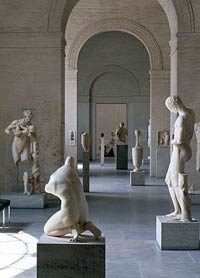 The Glyptothek am Konigsplatz in Munich, built between 1816 and 1830, holds Germany's largest collection of Greek and Roman sculpture. Dine prefers the spelling "Glyptotek," which refers to the term first used by Ludwig I, king of Bavaria, who commissioned the museum. Patterned after such Greek words as pinakotek (picture gallery) and bibliotek (library), glyptotek originates from the Greek work glyptikos, or the art of carving stone.
The Glyptothek am Konigsplatz in Munich, built between 1816 and 1830, holds Germany's largest collection of Greek and Roman sculpture. Dine prefers the spelling "Glyptotek," which refers to the term first used by Ludwig I, king of Bavaria, who commissioned the museum. Patterned after such Greek words as pinakotek (picture gallery) and bibliotek (library), glyptotek originates from the Greek work glyptikos, or the art of carving stone.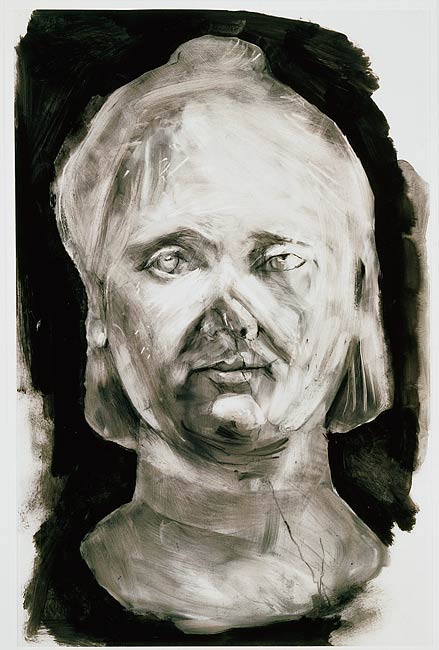
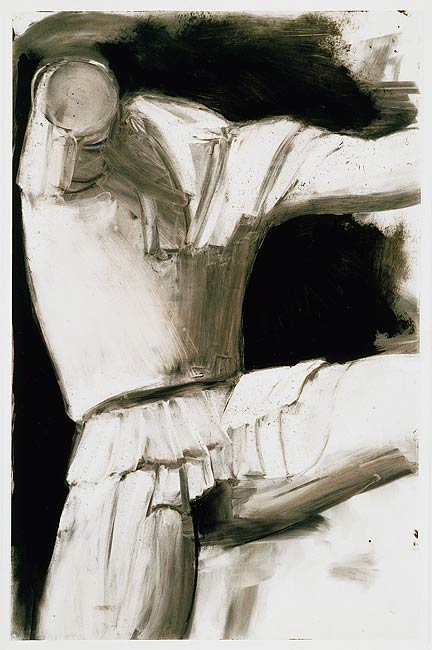
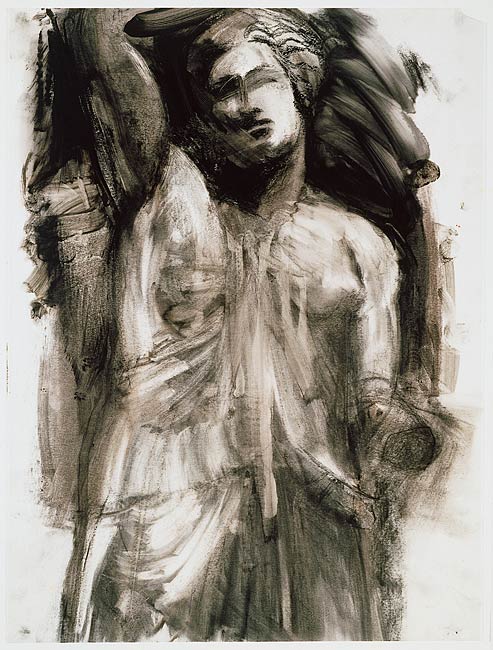
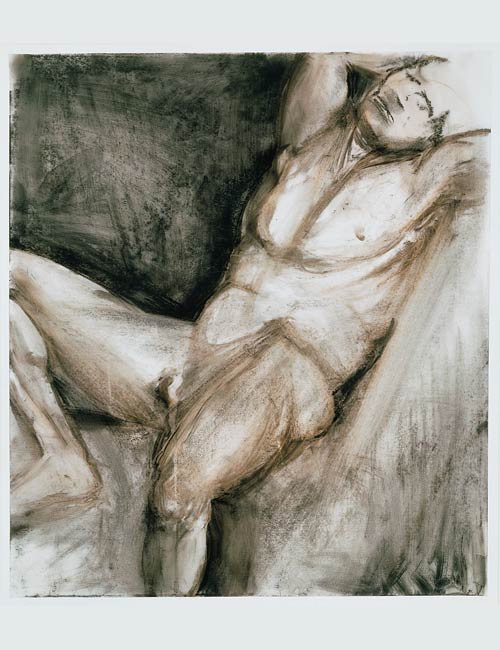
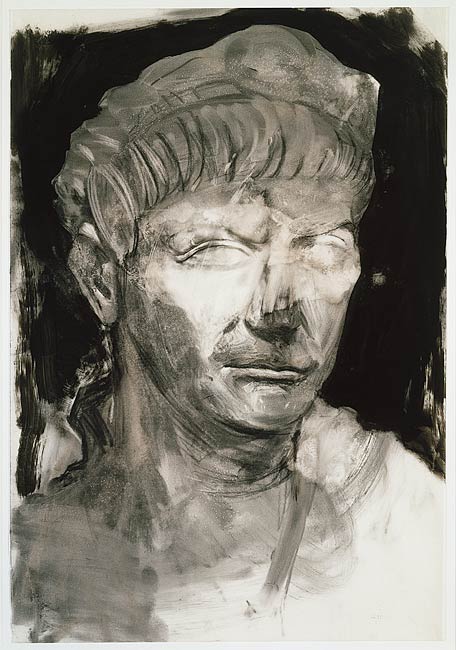
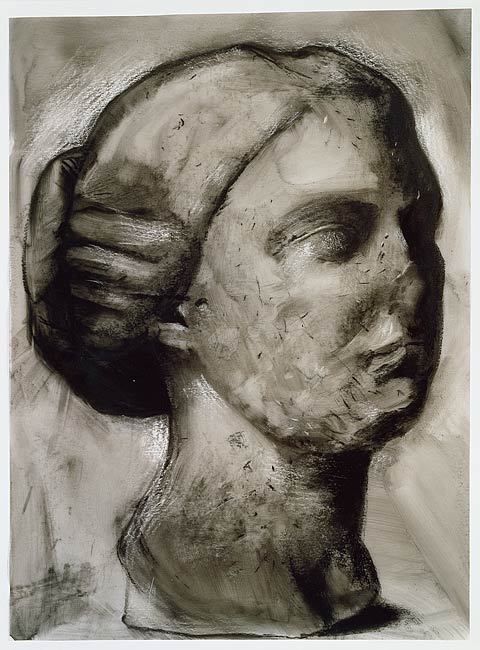




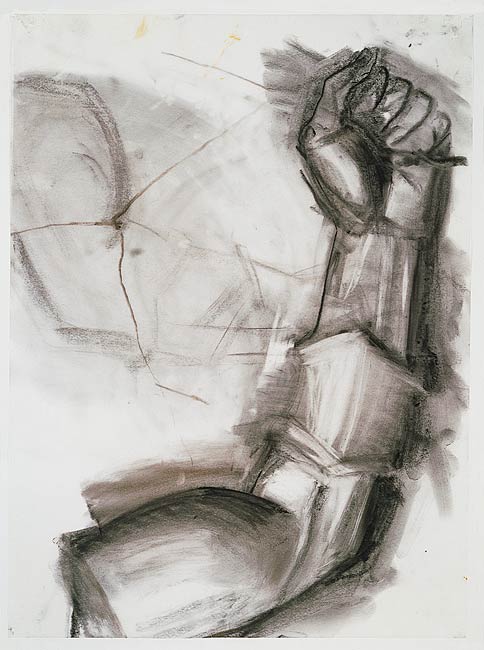


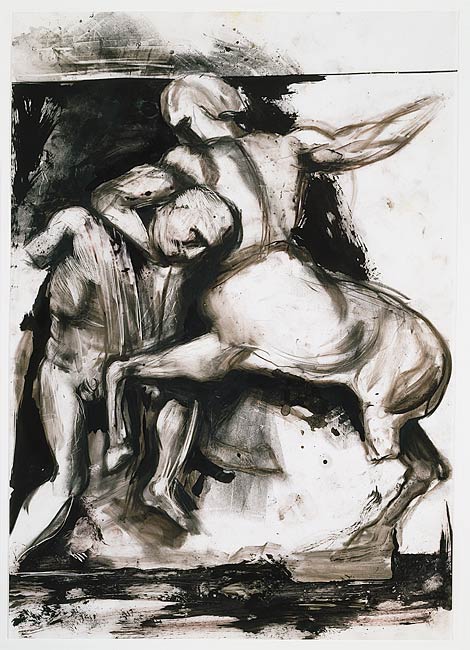

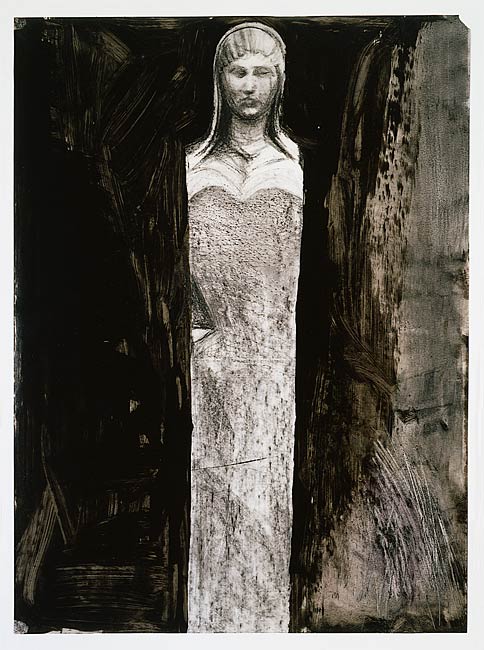
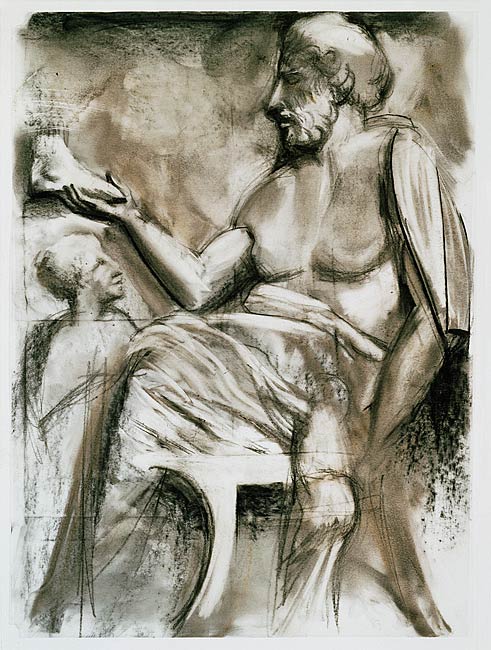






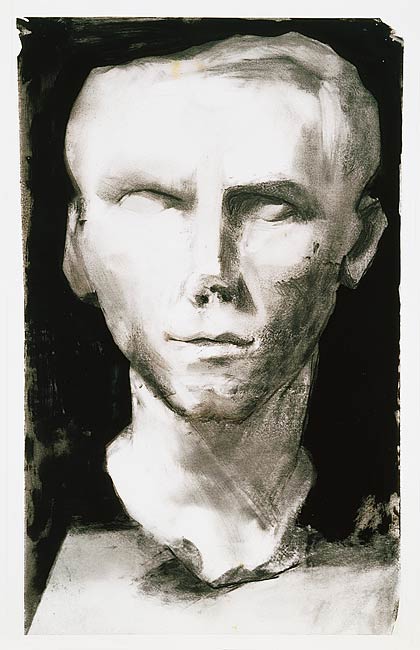
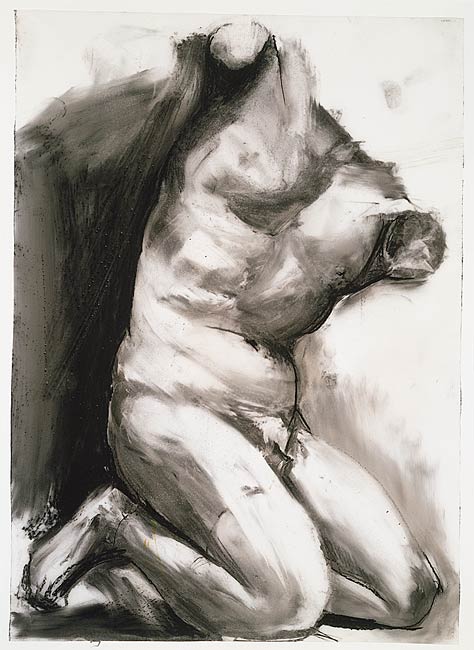
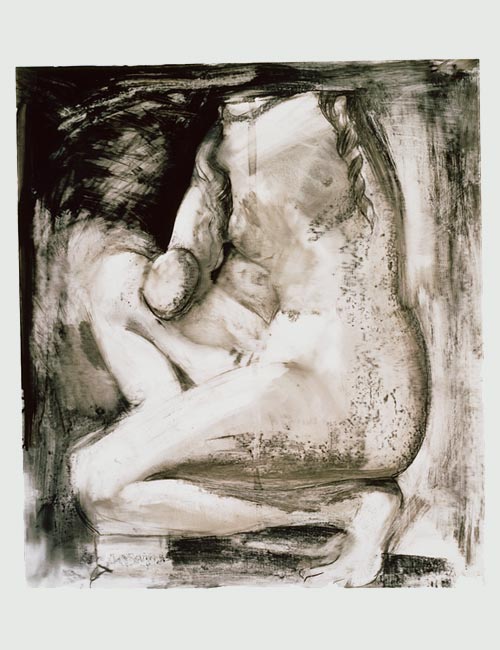
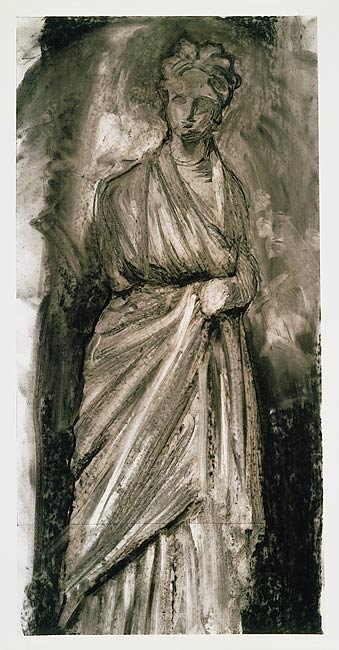

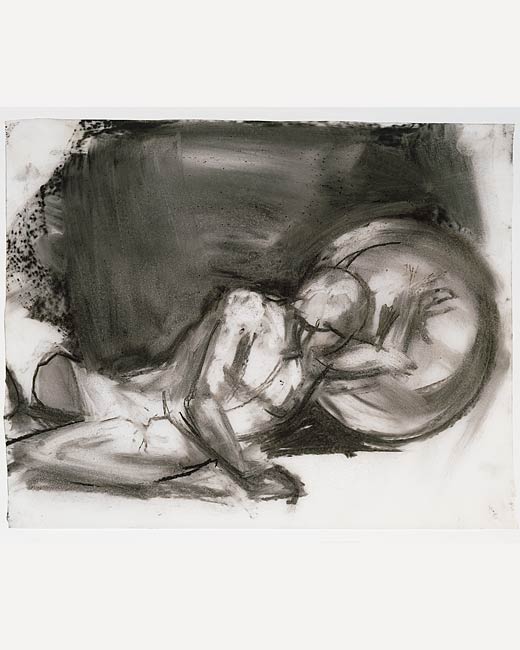
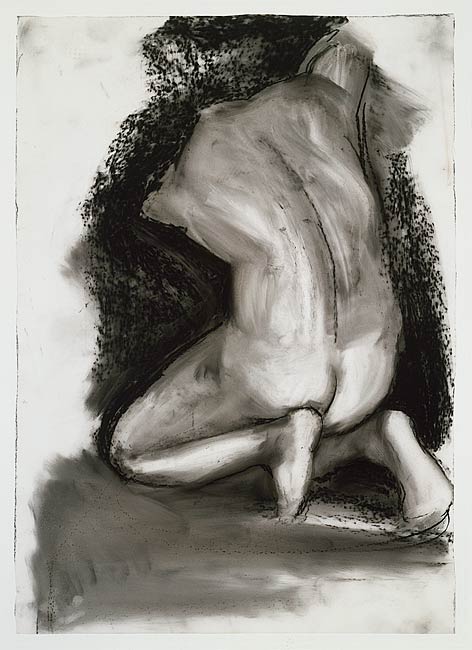
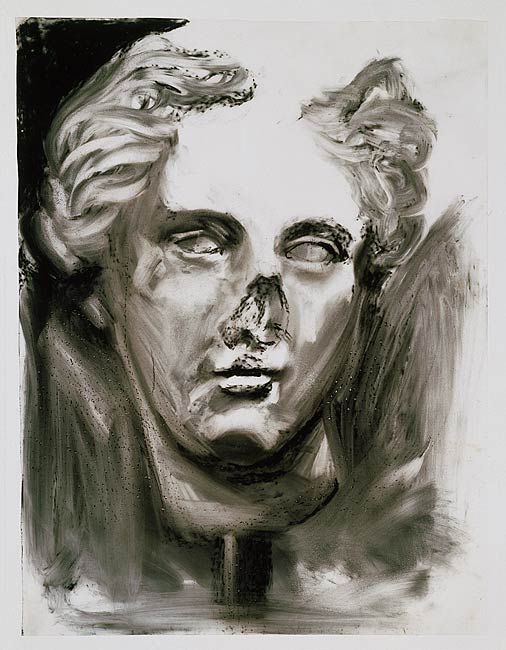
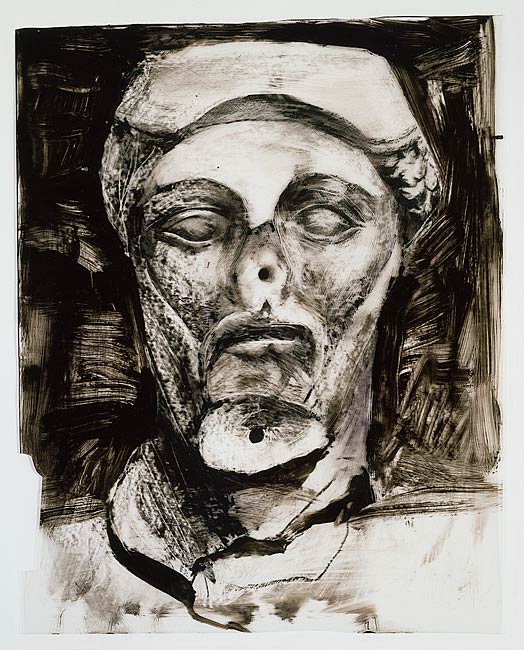
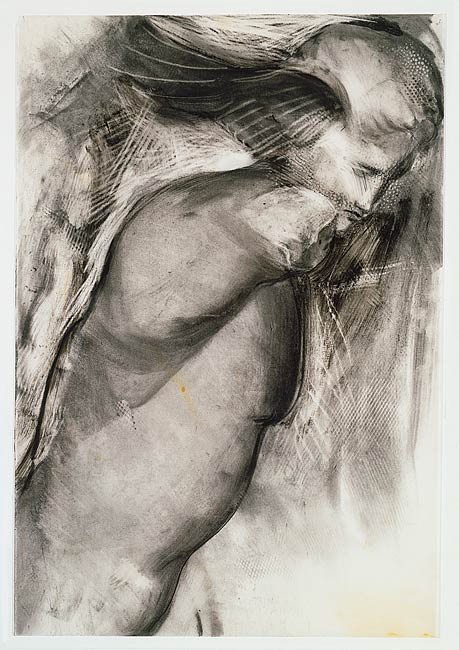




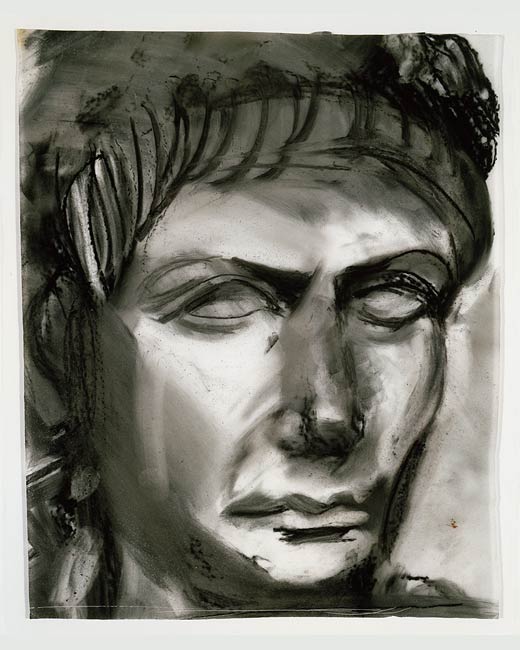
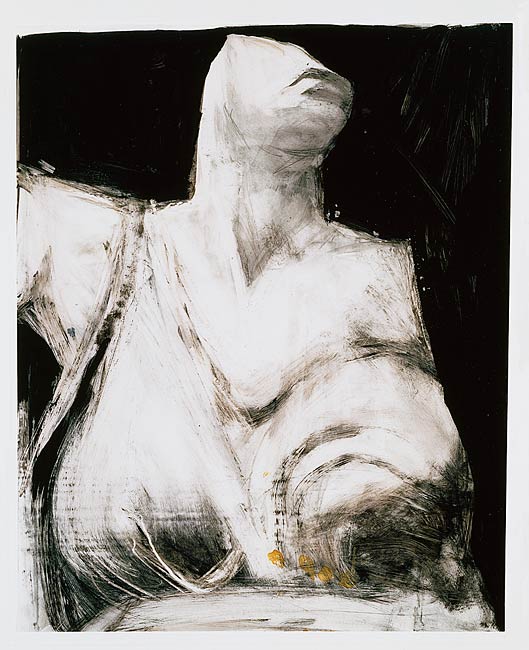

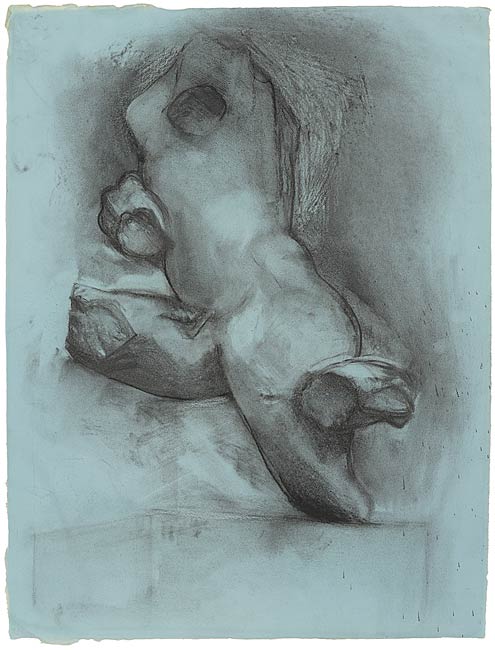
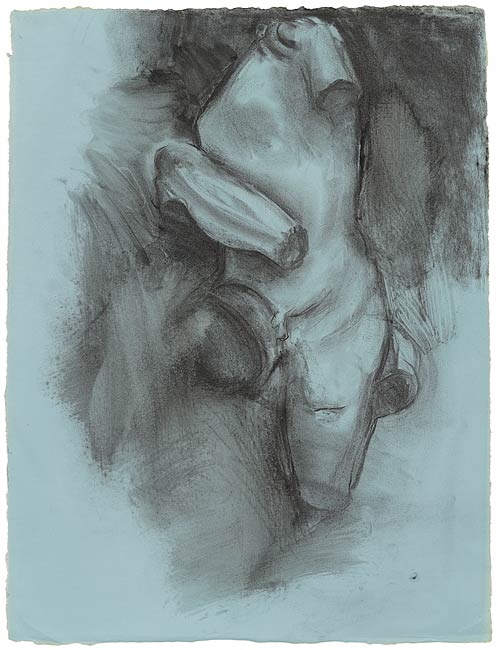
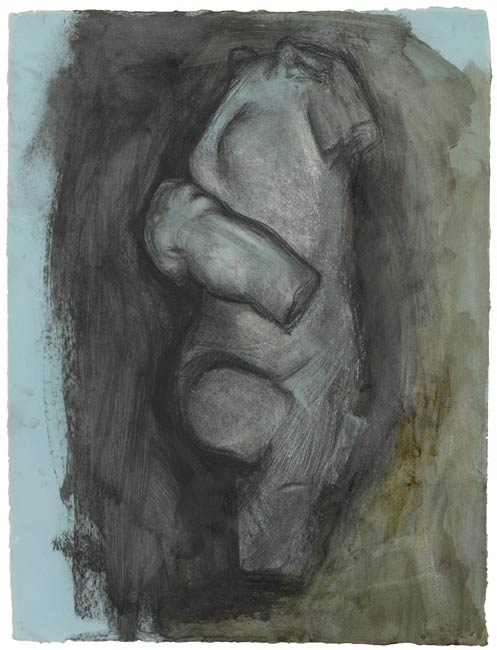
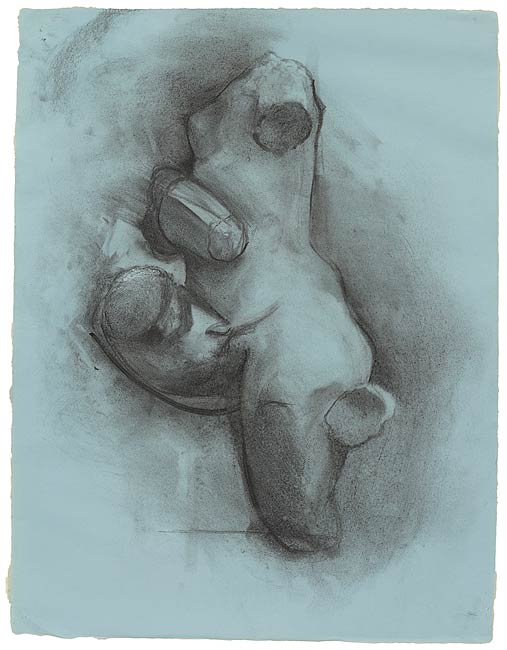

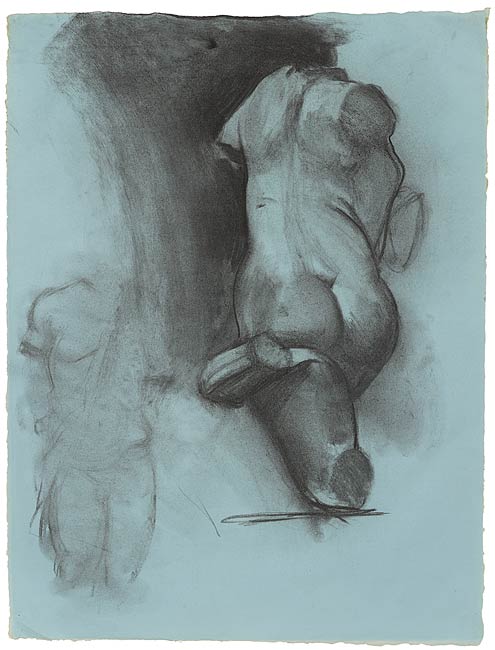
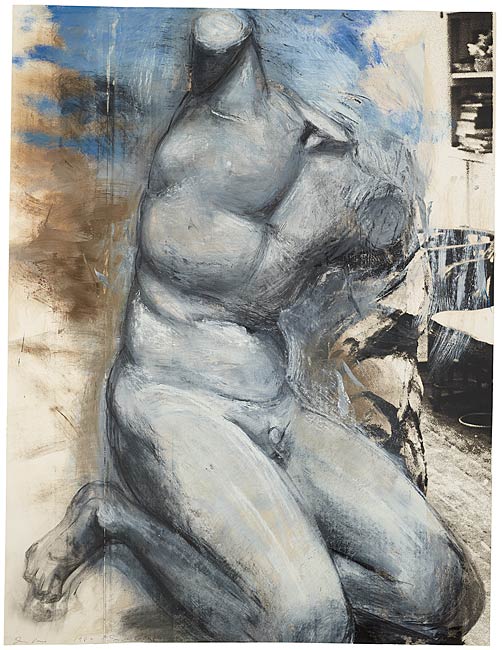
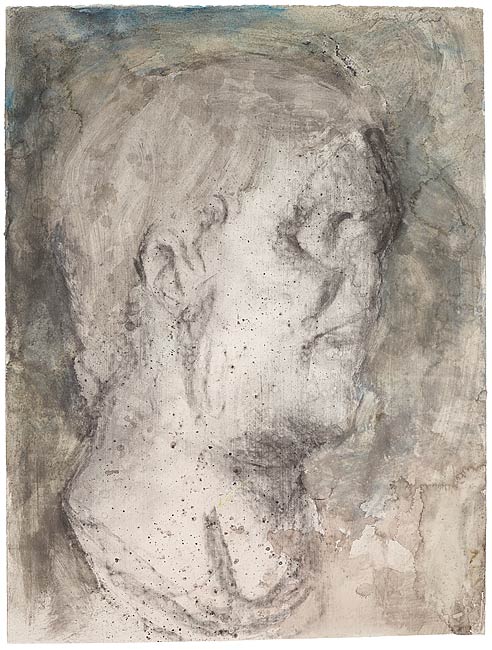

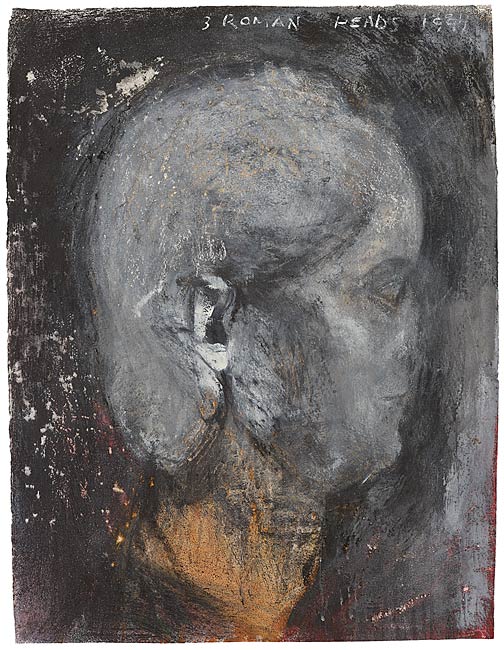
![Figure 2: Detail of Dine's fingerprints in the manipulated charcoal of Glyptotek Drawing [11]. Detail of Dine's fingerprints in the manipulated charcoal of Glyptotek Drawing [11].](/sites/default/files/images/blog/02_Drawing-11_detail.jpg)
![Figure 3: Detail of Glyptotek Drawing [9] showing texture from directly applied charcoal on the left, in contrast to the manipulated tonal area on the right. Detail of Glyptotek Drawing [9] showing texture from directly applied charcoal on the left, in contrast to the manipulated tonal area on the right.](/sites/default/files/images/blog/03_Drawing-9_detail.jpg)
![Figure 4: Glyptotek Drawing [36] Glyptotek Drawing [36]](/sites/default/files/images/blog/04_Drawing-36_whole.jpg)
![Figure 5: Examples of the three different frottage patterns found in these drawings: a rough pattern in Glyptotek Drawing [7] (detail) on the left; a dot pattern in Glyptotek Drawing [13] (detail) in the center; and a linear pattern in Glyptotek Drawing [17] (detail) on the right. Examples of the three different frottage patterns found in these drawings: a rough pattern in Glyptotek Drawing [7] (detail) on the left; a dot pattern in Glyptotek Drawing [13] (detail) in the center; and a linear pattern in Glyptotek Drawing [17] (detail) on the right.](/sites/default/files/images/blog/05_Drawing_7_13_17-combined.jpg)
![Figure 6: The same frottage pattern is visible in drawings that are on different supports. For example, the rough pattern is visible in Glyptotek Drawing [7] (detail) on a frosted plastic sheet on the left, as well as in Glyptotek Drawing [8] (detail) on paper on the right.](/sites/default/files/images/blog/06_Drawing_7_8-combined.jpg)
![Figure 7: Detail of the negative rough pattern in Glyptotek Drawing [7]. Detail of the negative rough pattern in Glyptotek Drawing [7].](/sites/default/files/images/blog/07_Drawing-7_neg-rough-pattern.jpg)
![Figure 8: The wire mesh Dine used to manipulate the media is seen in positive and negative in this detail of Glyptotek Drawing [34]. The wire mesh Dine used to manipulate the media is seen in positive and negative in this detail of Glyptotek Drawing [34].](/sites/default/files/images/blog/08_Drawing-34_diamond-mesh-detail.jpg)
![Figure 9: Detail of shoe print in Glyptotek Drawing [21]. Detail of shoe print in Glyptotek Drawing [21].](/sites/default/files/images/blog/09_Drawing-21_shoe-print.jpg)
![Figure 10: Detail of adhered eraser crumbs in Glyptotek Drawing [2]. Detail of adhered eraser crumbs in Glyptotek Drawing [2].](/sites/default/files/images/blog/10_Drawing-2_eraser-crumbs.jpg)
![Figure 11: Fine scratches from Dine's use of sandpaper can be seen in this detail of Glyptotek Drawing [33]. Fine scratches from Dine's use of sandpaper can be seen in this detail of Glyptotek Drawing [33].](/sites/default/files/images/blog/11_Drawing-33_sandpaper.jpg)
![Figure 12: Linear scraping appears wider or thinner depending on the angle of the tool; the detail of Glyptotek Drawing [6] on the left shows wider scraping, while the detail of Glyptotek Drawing [36] on the right shows thinner scraping. Linear scraping appears wider or thinner depending on the angle of the tool; the detail of Glyptotek Drawing [6] on the left shows wider scraping, while the detail of Glyptotek Drawing [36] on the right shows thinner scraping.](/sites/default/files/images/blog/12_Drawing_6_36-combined.jpg)
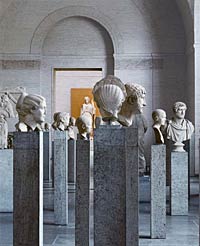 In der Glyptothek
In der Glyptothek